Monsters
ANGEL OF DECAY |
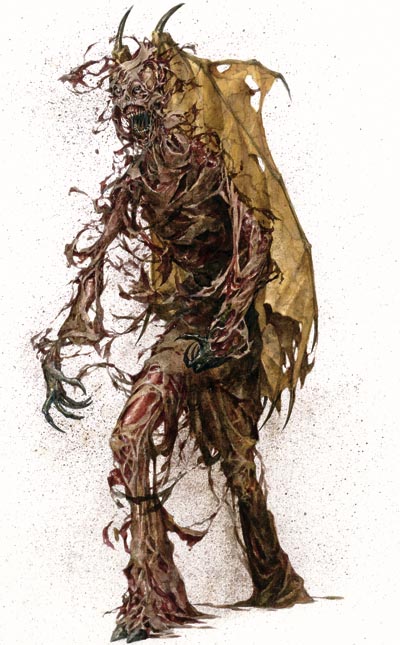 Large Undead
Hit Dice: 26d12 plus 29 (198 hp)
Initiative: +6
Speed: 30 ft. (6 squares), fly 50 ft. (poor)
Armor Class: 28 (–1 size, +2 Dex, +13 natural, +4 deflection), touch 15, flat-footed 26
Base Attack/Grapple: +13/+35
Attack: Claw +21 melee (2d6+18)*
Full Attack: 2 claws +21 melee (2d6+18) plus 2 wing slams +16 melee (1d6+11) plus rotting touch*
Space/Reach: 10 ft./10 ft.
Special Attacks: Rotting aura, rotting touch
Special Qualities: Damage reduction 10/adamantine and magic, darkvision 60 ft., spell resistance 24, undead traits, unholy grace
Saves: Fort +14, Ref +18, Will +26
Abilities: Str 37, Dex 14, Con —, Int 20, Wis 20, Cha 18
Skills: Concentration +29, Diplomacy +6, Hide +18, Knowledge (arcana) +29, Listen +29, Move Silently +26, Search +29, Sense Motive +29, Spellcraft +31, Spot +29, Survival +5 (+7 following tracks)
Feats: Cleave, Combat Reflexes, Great Fortitude, Improved Initiative, Improved Toughness†, Iron Will, Lightning Reflexes, Power Attack, Toughness
Environment: Any land and underground
Organization: Solitary
Challenge Rating: 15
Treasure: Standard
Alignment: Always chaotic evil
Advancement: 27–36 HD (Large); 37–63 HD (Huge)
Level Adjustment:— *Includes adjustments for Power Attack feat.
Large Undead
Hit Dice: 26d12 plus 29 (198 hp)
Initiative: +6
Speed: 30 ft. (6 squares), fly 50 ft. (poor)
Armor Class: 28 (–1 size, +2 Dex, +13 natural, +4 deflection), touch 15, flat-footed 26
Base Attack/Grapple: +13/+35
Attack: Claw +21 melee (2d6+18)*
Full Attack: 2 claws +21 melee (2d6+18) plus 2 wing slams +16 melee (1d6+11) plus rotting touch*
Space/Reach: 10 ft./10 ft.
Special Attacks: Rotting aura, rotting touch
Special Qualities: Damage reduction 10/adamantine and magic, darkvision 60 ft., spell resistance 24, undead traits, unholy grace
Saves: Fort +14, Ref +18, Will +26
Abilities: Str 37, Dex 14, Con —, Int 20, Wis 20, Cha 18
Skills: Concentration +29, Diplomacy +6, Hide +18, Knowledge (arcana) +29, Listen +29, Move Silently +26, Search +29, Sense Motive +29, Spellcraft +31, Spot +29, Survival +5 (+7 following tracks)
Feats: Cleave, Combat Reflexes, Great Fortitude, Improved Initiative, Improved Toughness†, Iron Will, Lightning Reflexes, Power Attack, Toughness
Environment: Any land and underground
Organization: Solitary
Challenge Rating: 15
Treasure: Standard
Alignment: Always chaotic evil
Advancement: 27–36 HD (Large); 37–63 HD (Huge)
Level Adjustment:— *Includes adjustments for Power Attack feat.
A repulsive, extremely tall, humanlike creature with long, rotting wings and peeling flesh, this monstrosity continually sheds rivulets of filth and decay, creating a pool of rot in which it stands.
A mockery of a true angel, an angel of decay may appear similar to an angelic outsider only by happenstance, not design. It is an undead creature that is powered by decay.
When a healthy creature softens, crumbles, and liquefies in death, an indefinable essence wafts away like putrid steam off stagnant beach sand. This decomposing flesh radiates an essential energy in its dissipation, and an angel of decay can extract the power resident therein.
An angel of decay stands about 9 feet tall and weighs between 500 and 700 pounds.
Angels of decay speak Common and Abyssal.
COMBAT
An angel of decay prefers to wade into combat, literally, since when it touches down, it produces a constantly renewing pool of liquid corruption.
An angel of decay normally attacks using its Power Attack feat, taking a –5 penalty on its attack rolls and gaining a +5 bonus on damage rolls.
Rotting Aura (Su): When the creature is not flying, rivulets of vile corruption stream from an angel of decay’s body, constantly regenerating and renewing a pool of odiferous rot all around the creature.
An angel of decay’s pool of rot is a 15-foot-radius spread. Any corporeal creature standing on the ground within that area must make a DC 24 Reflex saving throw each round or take 5d6 points of damage (half that on a successful save) as its flesh begins to succumb to decay. The creature must also succeed on a subsequent DC 24 Will saving throw (regardless of whether it succeeds on the first save) or be nauseated for 1 round.
In each round that a creature takes damage from an angel of decay’s rotting aura, the angel of decay heals 5 points of damage per victim.
Rotting Touch (Su): An angel of decay that hits a single foe with more than one attacks in a round rots its opponent’sflesh. This effect automatically deals an extra 1d6+6 points of damage and heals the angel of decay of 5 points of damage.
Unholy Grace (Su): An angel of decay adds its Charisma modifier as a bonus on all its saving throws and as a deflection bonus to its Armor Class. (The statistics block already reflects these bonuses.)
ATROPAL SCION |
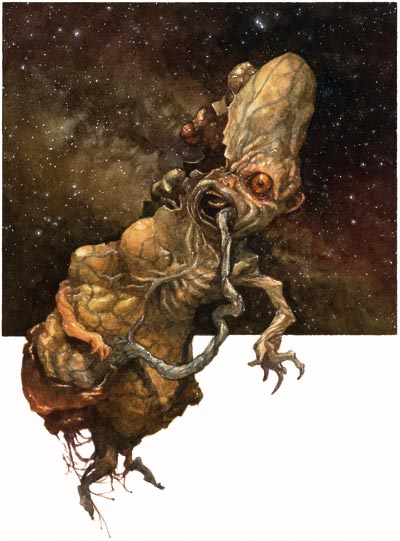 Medium Undead
Hit Dice: 9d12+9 (67 hp)
Initiative: +6
Speed: Fly 30 ft. (6 squares)
Armor Class: 25 (+2 Dex, +8 natural, +5 deflection), touch 17, flat-footed 23
Base Attack/Grapple: +4/+5
Attack: Slam +6 melee (1d8+1)
Full Attack: Slam +6 melee (1d8+1)
Space/Reach: 5 ft./5 ft.
Special Attacks: Death gaze, negative energy aura, spell-like abilities
Special Qualities: Damage reduction 10/ adamantine, darkvision 60 ft., fast healing 8, rebuke undead 5/day (+5, 2d6+14, 9th), undead traits, unholy grace
Saves: Fort +7, Ref +11, Will +16
Abilities: Str 13, Dex 15, Con —, Int 16, Wis 22, Cha 20
Skills: Listen +11, Knowledge (arcana) +8, Knowledge (religion) +8, Move Silently +10, Spot +11
Feats: Alertness, Improved Initiative, Improved Toughness†, Lightning Reflexes
Environment: Any
Organization: Solitary
Challenge Rating: 11
Treasure: None
Alignment: Always chaotic evil
Advancement: 10–13 HD (Medium); 14–27 HD (Large)
Level Adjustment:— †New feat described on page 27.
Medium Undead
Hit Dice: 9d12+9 (67 hp)
Initiative: +6
Speed: Fly 30 ft. (6 squares)
Armor Class: 25 (+2 Dex, +8 natural, +5 deflection), touch 17, flat-footed 23
Base Attack/Grapple: +4/+5
Attack: Slam +6 melee (1d8+1)
Full Attack: Slam +6 melee (1d8+1)
Space/Reach: 5 ft./5 ft.
Special Attacks: Death gaze, negative energy aura, spell-like abilities
Special Qualities: Damage reduction 10/ adamantine, darkvision 60 ft., fast healing 8, rebuke undead 5/day (+5, 2d6+14, 9th), undead traits, unholy grace
Saves: Fort +7, Ref +11, Will +16
Abilities: Str 13, Dex 15, Con —, Int 16, Wis 22, Cha 20
Skills: Listen +11, Knowledge (arcana) +8, Knowledge (religion) +8, Move Silently +10, Spot +11
Feats: Alertness, Improved Initiative, Improved Toughness†, Lightning Reflexes
Environment: Any
Organization: Solitary
Challenge Rating: 11
Treasure: None
Alignment: Always chaotic evil
Advancement: 10–13 HD (Medium); 14–27 HD (Large)
Level Adjustment:— †New feat described on page 27.
This creature’s hairless, overlarge head surmounts its wet, wrinkled, and bloated humanoid body. Its eyes are glassy and vacant. Its arms are too slender, and its tiny hands end in cruelly sharpened nails, while its legs are atrophied, dead things that hang useless below it.
Atropal scions are clots of divine flesh given form and animation by bleak-hearted gods of death. When a stillborn godling rises spontaneously as an undead, a great abomination is born. If that abomination is defeated, but any fragment or cast-off bit of flesh remains, an atropal scion may yet arise from those fragments, lessened in power from its divine beginnings, but no less hateful for its stature.
An atropal scion is a power to be reckoned with, and once animate in the world, seeks power over both life and unlife in an unrelenting bid for domination that only its lifeless tissue is able to sustain.
Atropal scions speak Common, Abyssal, Infernal, and Celestial.
COMBAT
A soul-numbing cold comes before and follows an atropal scion. The life energy of heroic creatures is suppressed in its foul aura, and the life force of lesser creatures is extinguished. It directs its spell-like abilities and death gaze upon those foes its mere presence cannot kill.
Death Gaze (Su): Death, range 60 feet; Fortitude DC 19 negates. The save DC is Charisma-based. Humanoids who die from this attack are transformed into wights 24 hours later.
Negative Energy Aura (Su): A 60-foot-radius negative energy aura surrounds an atropal scion. All undead in the aura (including the atropal scion) are treated as if they have +4 turn resistance and fast healing 5. Living creatures in the aura are treated as having two negative levels unless they have some sort of negative energy protection or protection from evil. Creatures with 2 or less HD fall dead in the negative energy aura (and, at the atropal scion’s option, rise as wights under the atropal scion’s command 1 minute later).
Rebuke Undead (Su): An atropal scion can rebuke or
command undead as a cleric of the same level as the atropal scion’s HD.
Spell Like Abilities: 3/day—animate dead, create undead, cone of cold (DC 18), desecrate, dispel magic, invisibility, plane shift, speak with dead, teleport. Caster level 9th.
Unholy Grace (Su): An atropal scion adds its Charisma modifier as a bonus on all its saving throws and as a deflection bonus to its Armor Class.
BLASPHEME |
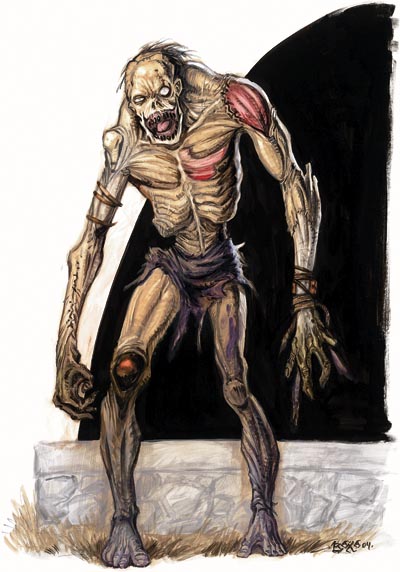 Medium Undead
Hit Dice: 18d12+30 (147 hp)
Initiative: +1
Speed: 40 ft. (8 squares)
Armor Class: 20 (+1 Dex, +9 natural), touch 11, flat-footed 15
Base Attack/Grapple: +9/+18
Attack: Bite +18 melee (1d8+13 plus blasphemous contact)
Full Attack: Bite +18 melee (1d8+13 plus blasphemous contact)
Space/Reach: 5 ft./5 ft.
Special Attacks: Blasphemous contact, erratic charge
Special Qualities: Darkvision 60 ft., damage reduction 5/slash, immunity to cold, inescapable craving, undead traits
Saves: Fort +6, Ref +7, Will +13
Abilities: Str 28, Dex 12, Con —, Int 5, Wis 15, Cha 10
Skills: Listen +10, Spot +10, Survival +7
Feats: Improved Natural Attack (bite), Improved Toughness†, Toughness (4), Track
Environment: Cold plains or cold hills
Organization: Solitary or pair
Challenge Rating: 9
Treasure: None
Alignment: Always neutral evil
Advancement: 19–36 HD (Medium)
Level Adjustment:—
Medium Undead
Hit Dice: 18d12+30 (147 hp)
Initiative: +1
Speed: 40 ft. (8 squares)
Armor Class: 20 (+1 Dex, +9 natural), touch 11, flat-footed 15
Base Attack/Grapple: +9/+18
Attack: Bite +18 melee (1d8+13 plus blasphemous contact)
Full Attack: Bite +18 melee (1d8+13 plus blasphemous contact)
Space/Reach: 5 ft./5 ft.
Special Attacks: Blasphemous contact, erratic charge
Special Qualities: Darkvision 60 ft., damage reduction 5/slash, immunity to cold, inescapable craving, undead traits
Saves: Fort +6, Ref +7, Will +13
Abilities: Str 28, Dex 12, Con —, Int 5, Wis 15, Cha 10
Skills: Listen +10, Spot +10, Survival +7
Feats: Improved Natural Attack (bite), Improved Toughness†, Toughness (4), Track
Environment: Cold plains or cold hills
Organization: Solitary or pair
Challenge Rating: 9
Treasure: None
Alignment: Always neutral evil
Advancement: 19–36 HD (Medium)
Level Adjustment:—
Appearing similar to a corpse that has been dug up and surgically modified, this creature stands nearly 7 feet tall, but is extraordinarily thin. Its arms are extra long, hanging nearly to mid-calf. Its head is wide and wedge-shaped, with a split mouth that opens wider than that of a normal humanoid. Its teeth glitter like shards of black, steaming ice.
Crafted in bygone days by power-mad wizards searching to create the perfect undead guardians, blasphemes still roam forgotten areas, seeking to destroy nonevil creatures with their blasphemous bite. They are most likely to be encountered near ruins of ancient cities where magic was valued more highly than personal liberty or morals. If the secret of creating or calling a blaspheme into the world still exists, it is buried in just such a location.
Each blaspheme is created with parts from multiple ancient corpses, with teeth specially harvested from sacrifices to evil powers. However, blasphemes are not hulking, slow-moving constructs; rather, they are lithe and deadly, aware of their surroundings and capable of directing their own actions.
Blasphemes stand just under 7 feet tall and weigh about 190 pounds.
Blasphemes speak Common.
COMBAT
A blaspheme resonates with evil power, the focus of which is concentrated in its teeth. Thus, blasphemes charge into combat in almost every situation, attempting to bite their victims as quickly as possible.
Blasphemous Contact (Su): Each time a blaspheme bites a nonevil creature, the creature is dazed for 1 round and takes 1d6 points of Strength damage. There is no saving throw against this effect.
Erratic Charge (Ex): When a blaspheme charges, it can make one turn of up to 90 degrees during its movement. All other restrictions on charges still apply. For instance, it cannot pass through a square that blocks or slows movement, or one that contains a creature. A blaspheme must have line of sight to a targeted opponent at the start of its turn.
Inescapable Craving: A blaspheme has an inescapable craving (see the Undead Metabolism section in Chapter 1) for Strength, which it satisfies by using its blasphemous contact ability.
BLEAKBORN |
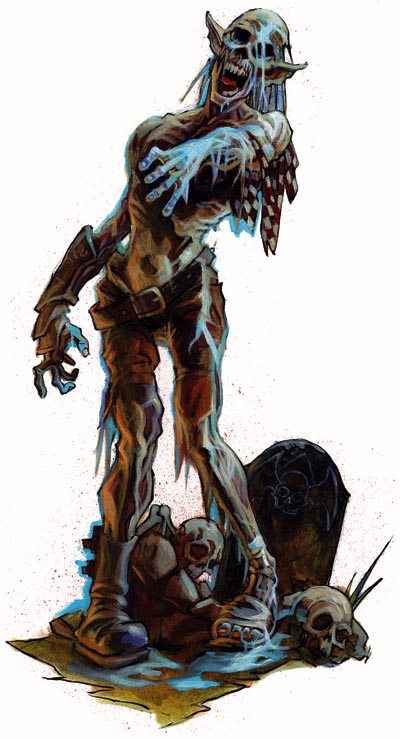 Medium Undead
Hit Dice: 8d12 (52 hp)
Initiative: +3
Speed: 30 ft. (6 squares)
Armor Class: 27 (+3 Dex, +14 natural), touch 13, flat-footed 24
Base Attack/Grapple: +4/—
Attack: Slam +10 melee (1d6+9 plus 2d6 cold)
Full Attack: Slam +10 melee (1d6+9 plus 2d6 cold)
Space/Reach: 5 ft./5 ft.
Special Attacks: Cold to the touch, create spawn, heatdraining aura
Special Qualities: Contingent healing 10, darkvision 60 ft., diet dependent, fire lover, undead traits, +2 turn resistance
Saves: Fort +2, Ref +7, Will +8
Abilities: Str 22, Dex 16, Con —, Int 14, Wis 14, Cha 15
Skills: Diplomacy +6, Hide +11, Intimidate +10, Listen +12, Search +10, Sense Motive +8, Spot +12, Survival +2 (+4 following tracks)
Feats: Alertness, Combat Reflexes, Lightning Reflexes
Environment: Any
Organization: Solitary
Challenge Rating: 7
Treasure: None
Alignment: Always neutral evil
Advancement: 6–10 HD (Medium)
Level Adjustment:—
Medium Undead
Hit Dice: 8d12 (52 hp)
Initiative: +3
Speed: 30 ft. (6 squares)
Armor Class: 27 (+3 Dex, +14 natural), touch 13, flat-footed 24
Base Attack/Grapple: +4/—
Attack: Slam +10 melee (1d6+9 plus 2d6 cold)
Full Attack: Slam +10 melee (1d6+9 plus 2d6 cold)
Space/Reach: 5 ft./5 ft.
Special Attacks: Cold to the touch, create spawn, heatdraining aura
Special Qualities: Contingent healing 10, darkvision 60 ft., diet dependent, fire lover, undead traits, +2 turn resistance
Saves: Fort +2, Ref +7, Will +8
Abilities: Str 22, Dex 16, Con —, Int 14, Wis 14, Cha 15
Skills: Diplomacy +6, Hide +11, Intimidate +10, Listen +12, Search +10, Sense Motive +8, Spot +12, Survival +2 (+4 following tracks)
Feats: Alertness, Combat Reflexes, Lightning Reflexes
Environment: Any
Organization: Solitary
Challenge Rating: 7
Treasure: None
Alignment: Always neutral evil
Advancement: 6–10 HD (Medium)
Level Adjustment:—
This frigid corpse is so cold that it is frosted with icy crystals. Sensing the warmth of life, it shambles eagerly toward its victims. Its eyes reflect the vacuum of the void, its touch chills to the bone, and its very presence seems to drain the heat from your pores.
When inactive, a bleakborn appears to be nothing but a humanoid corpse, slain either by bitterly cold conditions (or if in a warmer environment, as if by a magical cold attack so potent that the corpse still sparkles with ice crystals). However, whenever any living creature comes to within 30 feet of an inactive bleakborn, the warmth and life of the interloper revive the undead creature, giving it purpose and a icy semblance of life.
Bleakborns are also referred to as Moil zombies in some lesser-known tomes about undead, in supposed reference to the cursed city in which they first arose. A bleakborn is not marked by direct violence; rather, it looks like a humanoid that has been flash-frozen, with discoloration and some ruptured flesh showing here and there.
A bleakborn stands a little over 6 feet tall and weighs between 150 and 230 pounds.
Bleakborns speak Common and their own language (called Moilian).
COMBAT
A bleakborn actively moves toward living creatures, attempting to keep them within range of its heat-draining aura. If possible, a bleakborn pummels a living creature with its ice-cold limbs, hoping to deprive its victim of all warmth and life.
Cold to the Touch (Su): The touch of a bleakborn deals 2d6 points of cold damage. Each 3 points of cold damage dealt heals a bleakborn of 1 point of damage. If this amount of healing would cause a bleakborn to exceed its full normal hit point total, it gains any excess as temporary hit points. These temporary hit points last for up to 1 hour. Anyone who hits a bleakborn in melee also takes 1d6 points of cold damage, unless wielding a reach weapon.
Contingent Healing: A bleakborn only heals when in range of a living creature that it can affect with its heat-draining aura. Even if brought to 0 hit points or less, a bleakborn eventually heals if a living creature at some future date wanders within 30 feet of the bleakborn’s remains, automatically triggering its heat-draining aura. As long as affected creatures are within its heat-draining aura, a bleakborn’s contingent healing remains active.
A bleakborn does not have immunity to cold. While a bleakborn doesn’t take cold damage from its own abilities, it can take cold damage from another of its kind.
Create Spawn (Su): Any humanoid slain by a bleakborn becomes a normal zombie in 1d4 rounds. These spawn are under the command of the bleakborn that created them and remain enslaved until its destruction. They do not possess any of the abilities they had in life.
Sometimes a newly created spawn becomes a bleakborn instead of a mere zombie, though the wiles of the dark gods determine such instances (that is, the DM decides when this occurs).
Diet Dependent: Bleakborns are diet dependent (see the Undead Metabolism section in Chapter 1) upon warmth, which they gain through their heatdraining aura, as described below.
Fire Lover (Su): A magical fire attack heals a bleakborn of 1 point of damage for each 3 points of damage the attack would otherwise deal. If this amount of healing would cause bleakborn to exceed its full normal hit point total, it gains any excess as temporary hit points. These temporary hit points last for up to 1 hour. For example, a bleakborn hit by a fireball that would normally deal 18 points of damage instead gains 6 hit points. A bleakborn makes no saving throws against fire effects.
Heat-Draining Aura (Su): All living creatures (except those immune to cold damage) that approach within 30 feet of a bleakborn are subject to its heat-draining aura. Victims must make a DC 16 Fortitude save. If they fail, they take 2d6 hit points of cold damage per round as their living heat is sucked away, but if they succeed, they lose only 1d6 hit points per round that they remain in the radius. Should a bleakborn kill a humanoid creature with its heat-draining aura, the victim rises again as a bleakborn spawn. The save DC is Charisma-based.
BLOOD AMNIOTE |
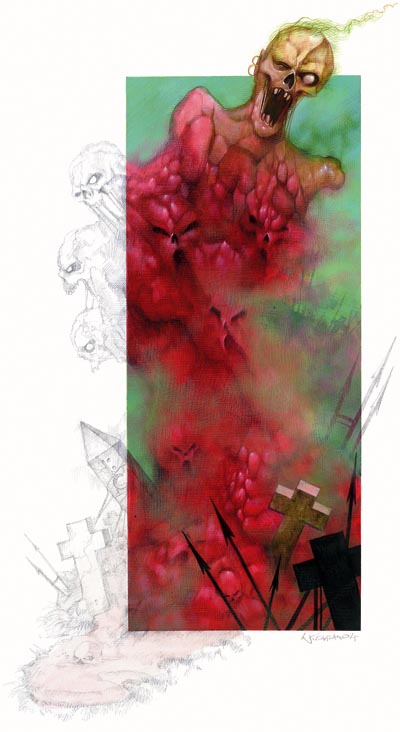 Huge Undead
Hit Dice: 10d12 (65 hp)
Initiative: +5
Speed: 30 ft. (6 squares), climb 20 ft.
Armor Class: 26 (–2 size, +5 Dex, +13 natural), touch 13, flatfooted 11
Base Attack/Grapple: +7/+18
Attack: Slam +9 melee (2d6+6 plus blood call)
Full Attack: Slam +9 melee (2d6+6 plus blood call)
Space/Reach: 15 ft./10 ft.
Special Attacks: Blood call
Special Qualities: Blindsight 60 ft., damage reduction 10/—, darkvision 60 ft., fast healing 5, inescapable craving, ooze traits, self spawn, undead traits
Saves: Fort +3, Ref +8, Will –2
Abilities: Str 19, Dex 20, Con —, Int —, Wis 1, Cha 1
Skills: —
Feats: —
Environment: Underground
Organization: Solitary, pair, or amnion (4–8)
Challenge Rating: 9
Treasure: None
Alignment: Always neutral
Advancement: 11–15 HD (Huge); 16–30 HD (Gargantuan)
Level Adjustment:—
Huge Undead
Hit Dice: 10d12 (65 hp)
Initiative: +5
Speed: 30 ft. (6 squares), climb 20 ft.
Armor Class: 26 (–2 size, +5 Dex, +13 natural), touch 13, flatfooted 11
Base Attack/Grapple: +7/+18
Attack: Slam +9 melee (2d6+6 plus blood call)
Full Attack: Slam +9 melee (2d6+6 plus blood call)
Space/Reach: 15 ft./10 ft.
Special Attacks: Blood call
Special Qualities: Blindsight 60 ft., damage reduction 10/—, darkvision 60 ft., fast healing 5, inescapable craving, ooze traits, self spawn, undead traits
Saves: Fort +3, Ref +8, Will –2
Abilities: Str 19, Dex 20, Con —, Int —, Wis 1, Cha 1
Skills: —
Feats: —
Environment: Underground
Organization: Solitary, pair, or amnion (4–8)
Challenge Rating: 9
Treasure: None
Alignment: Always neutral
Advancement: 11–15 HD (Huge); 16–30 HD (Gargantuan)
Level Adjustment:—
A clot of animate blood the size of a small house, this amoeba of failed life is hungry to add new blood to its oozing body.
The half-congealed blood of past victims gives a blood amniote its form, and its ties to the Negative Energy Plane give the creature animation. Mindless, it seeks only to pierce the fleshy carapace of all living creatures it comes upon so it can draw out the blood beneath.
Though these creatures are mindless, vestiges of past victims completely drained of blood remain imprinted on them. Observers sometimes see these random memories as faces that briefly form on the surface of a blood amniote, only to fall away again to formlessness moments later.
COMBAT
When a blood amniote senses potential prey, it quickly moves to engage, hoping to draw out the blood of its victims in full quantity.
Blood Call (Su): Whenever a blood amniote strikes a living creature in melee combat, its touch causes the target’s body to expel a portion of its own blood through the pores. The expelled blood gathers and flows across the intervening distance between the prey and the blood amniote. This attack deals 1d4 points of Constitution damage to the foe.
If a blood amniote deals as many points of Constitution damage during its existence as its full normal hit point total, it self spawns (see below).
Inescapable Craving: A blood amniote has an inescapable craving (see the Undead Metabolism section in Chapter 1) for blood, which it satisfies by using its blood call ability.
Ooze Traits: Despite being undead, a blood amniote has all the benefits and disadvantages of being an ooze. Like oozes, blood amniotes do not receive any feats. Blood amniotes are mindless and are immune to all mind-affecting spells and abilities, and they are blind, giving them immunity to gaze attacks, visual effects, illusions, and other attack forms that rely on sight. Blood amniotes also have immunity to poison, magic sleep effects, paralysis, polymorph, and stunning, and they are not subject to extra damage from critical hits or flanking.
Self Spawn (Ex): If a blood amniote deals as many points of Constitution damage during its existence as its full normal hit point total, it self spawns, splitting into two identical blood amniotes, each with a number of hit points equal to the original blood amniote’s full normal total.
BLOODMOTE CLOUD |
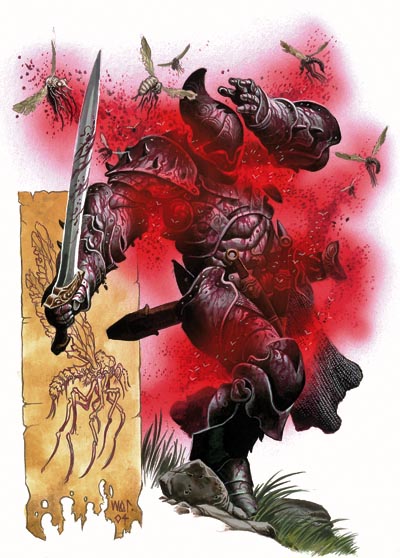 Fine Undead (Swarm)
Hit Dice: 10d12 (65 hp)
Initiative:—
Speed: Fly 20 ft. (4 squares)
Armor Class: 19 (+8 size, +1 Dex), touch 11, flat-footed 18
Base Attack/Grapple: +5/—
Attack: Swarm (1d4 plus blood drain)
Full Attack: Swarm (1d4 plus blood drain)
Space/Reach: 10 ft./0 ft.
Special Attacks: Blood drain, distraction
Special Qualities: Darkvision 60 ft., diet dependent, immune to weapon damage, swarm traits, undead traits
Saves: Fort +2, Ref +3, Will +6
Abilities: Str 4, Dex 13, Con —, Int —, Wis 10, Cha 1
Skills:—
Feats:—
Environment: Any
Organization: Solitary, cloud (2–4 swarms), or infestation (7–12 swarms)
Challenge Rating: 6
Treasure: None
Alignment: Always neutral evil
Advancement: None
Level Adjustment:—
Fine Undead (Swarm)
Hit Dice: 10d12 (65 hp)
Initiative:—
Speed: Fly 20 ft. (4 squares)
Armor Class: 19 (+8 size, +1 Dex), touch 11, flat-footed 18
Base Attack/Grapple: +5/—
Attack: Swarm (1d4 plus blood drain)
Full Attack: Swarm (1d4 plus blood drain)
Space/Reach: 10 ft./0 ft.
Special Attacks: Blood drain, distraction
Special Qualities: Darkvision 60 ft., diet dependent, immune to weapon damage, swarm traits, undead traits
Saves: Fort +2, Ref +3, Will +6
Abilities: Str 4, Dex 13, Con —, Int —, Wis 10, Cha 1
Skills:—
Feats:—
Environment: Any
Organization: Solitary, cloud (2–4 swarms), or infestation (7–12 swarms)
Challenge Rating: 6
Treasure: None
Alignment: Always neutral evil
Advancement: None
Level Adjustment:—
This cloud of buzzing insects boils toward its victims, droning ominously in its strangely deep pitch and accompanied by the sickly sweet aroma of blood.
A bloodmote cloud is made up of undead mosquitoes with a blood thirst. While a living mosquito is hardly more than an annoyance, and a swarm of the same is hardly cause for alarm, the appearance of a concentrated swarm of undead bloodsuckers is a calamity.
COMBAT
A bloodmote cloud seeks to engulf and suck dry any living prey it encounters. A bloodmote cloud is never sated.
Blood Drain (Ex): A bloodmote cloud drains blood and deals 1d3 points of damage and 1d2 points of Constitution damage to any creature whose space it occupies at the end of its move.
Diet Dependent: A bloodmote cloud is diet dependent (see the Undead Metabolism section in Chapter 1) upon blood, which it consumes by using its blood drain ability.
Distraction (Ex): Any living creature that begins its turn with a bloodmote cloud in its space must succeed on a DC 15 Fortitude save or be nauseated for 1 round. The save DC is Constitution-based.
BONE RAT SWARM |
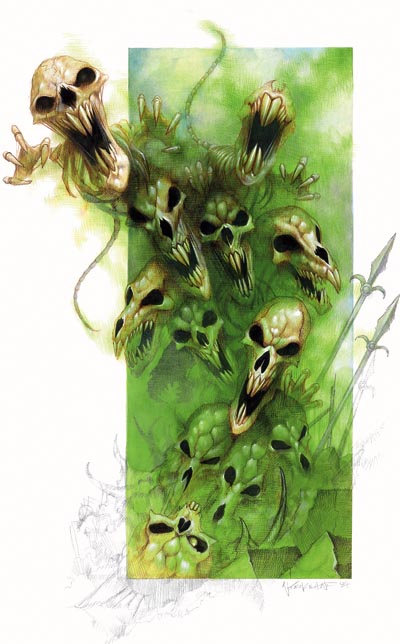 Tiny Undead (Swarm)
Hit Dice: 4d12 (26 hp)
Initiative: +3
Speed: 15 ft. (3 squares), climb 15 ft.
Armor Class: 15 (+2 size, +3 Dex), touch 15, flat-footed 12
Base Attack/Grapple: +2/—
Attack: Swarm (1d6)
Full Attack: Swarm (1d6)
Space/Reach: 10 ft./0 ft.
Special Attacks: Distraction
Special Qualities: Damage reduction 5/bludgeoning, darkvision 60 ft., half damage from slashing and piercing weapons, immunity to cold, swarm traits, undead traits
Saves: Fort +1, Ref +4, Will +4
Abilities: Str 2, Dex 17, Con —, Int —, Wis 10, Cha 1
Skills:—
Feats:—
Environment: Any
Organization: Solitary, pack (2–4 swarms), or infestation (7–12 swarms)
Challenge Rating: 3
Treasure: None
Alignment: Always neutral evil
Advancement: None
Level Adjustment:—
Tiny Undead (Swarm)
Hit Dice: 4d12 (26 hp)
Initiative: +3
Speed: 15 ft. (3 squares), climb 15 ft.
Armor Class: 15 (+2 size, +3 Dex), touch 15, flat-footed 12
Base Attack/Grapple: +2/—
Attack: Swarm (1d6)
Full Attack: Swarm (1d6)
Space/Reach: 10 ft./0 ft.
Special Attacks: Distraction
Special Qualities: Damage reduction 5/bludgeoning, darkvision 60 ft., half damage from slashing and piercing weapons, immunity to cold, swarm traits, undead traits
Saves: Fort +1, Ref +4, Will +4
Abilities: Str 2, Dex 17, Con —, Int —, Wis 10, Cha 1
Skills:—
Feats:—
Environment: Any
Organization: Solitary, pack (2–4 swarms), or infestation (7–12 swarms)
Challenge Rating: 3
Treasure: None
Alignment: Always neutral evil
Advancement: None
Level Adjustment:—
With the scrabble of hundreds of bony claws, a mass of tiny skeletal creatures surges across the floor, with pinpoints of red light gleaming in their empty eye sockets.
A bone rat swarm is a mass of undead skeletal rats. Though individually such creatures would pose little risk, in great numbers they can strip a creature clean in short order.
COMBAT
A bone rat swarm seeks to engulf and devour any living prey it encounters. A bone rat swarm deals 1d6 points of damage to any creature whose space it occupies at the end of its move.
Distraction (Ex): Any living creature that begins its turn with a bone rat swarm in its space must succeed on a DC 15 Fortitude save or be nauseated for 1 round. The save DC is Constitution-based.
BONEYARD |
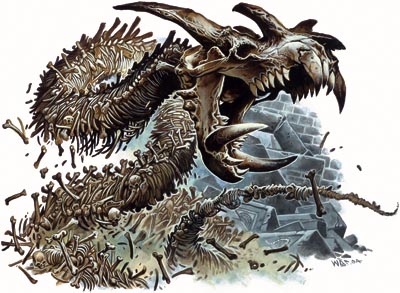 Huge Undead
Hit Dice: 17d12+17 (127 hp)
Initiative: +6
Speed: 20 ft. (4 squares), fly 60 ft. (good)
Armor Class: 30 (–2 size, +2 Dex, +20 natural), touch 10, flat-footed 28
Base Attack/Grapple: +8/+26
Attack: Bite +16 melee (2d8+15/19–20 plus bone subsumption)
Full Attack: Bite +16 melee (2d8+15/19–20 plus bone subsumption)
Space/Reach: 15 ft./10 ft.
Special Attacks: Bone subsumption, improved grab, summon skeletons, utter subsumption
Special Qualities: Damage reduction 10/—, darkvision 60 ft., fast healing 10, immunity to cold, inescapable craving, spell resistance 24, undead traits
Saves: Fort +7, Ref +9, Will +15
Abilities: Str 31, Dex 14, Con —, Int 18, Wis 20, Cha 18
Skills: Balance +22, Climb +30, Hide +22, Jump +30, Listen +25, Move Silently +22, Search +24, Spot +25
Feats: Combat Reflexes, Dodge, Great Fortitude, Improved Critical (bite), Improved Initiative, Improved Toughness†, Lightning Reflexes
Environment: Any
Organization: Solitary
Challenge Rating: 14
Treasure: Standard
Alignment: Always chaotic evil
Advancement: 18–25 HD (Huge); 26–51 HD (Gargantuan)
Level Adjustment:— †New feat described on page 27.
Huge Undead
Hit Dice: 17d12+17 (127 hp)
Initiative: +6
Speed: 20 ft. (4 squares), fly 60 ft. (good)
Armor Class: 30 (–2 size, +2 Dex, +20 natural), touch 10, flat-footed 28
Base Attack/Grapple: +8/+26
Attack: Bite +16 melee (2d8+15/19–20 plus bone subsumption)
Full Attack: Bite +16 melee (2d8+15/19–20 plus bone subsumption)
Space/Reach: 15 ft./10 ft.
Special Attacks: Bone subsumption, improved grab, summon skeletons, utter subsumption
Special Qualities: Damage reduction 10/—, darkvision 60 ft., fast healing 10, immunity to cold, inescapable craving, spell resistance 24, undead traits
Saves: Fort +7, Ref +9, Will +15
Abilities: Str 31, Dex 14, Con —, Int 18, Wis 20, Cha 18
Skills: Balance +22, Climb +30, Hide +22, Jump +30, Listen +25, Move Silently +22, Search +24, Spot +25
Feats: Combat Reflexes, Dodge, Great Fortitude, Improved Critical (bite), Improved Initiative, Improved Toughness†, Lightning Reflexes
Environment: Any
Organization: Solitary
Challenge Rating: 14
Treasure: Standard
Alignment: Always chaotic evil
Advancement: 18–25 HD (Huge); 26–51 HD (Gargantuan)
Level Adjustment:— †New feat described on page 27.
The pile of bones before you stirs. The bones rise and reform, and as each bone finds its proper place, the shape of a huge serpentine creature emerges, one whose form is composed of interlocking bones, its head the skull of some unnamed and long-dead beast.
A boneyard is an undead creature made entirely from the bones of other dead creatures. However, unlike a skeleton or similar monster, a boneyard’s form is fluid in the sense that it can appear merely as a pile of bones, or as a serpent composed of bones, or some other form of its choice. Boneyards have been called by many names, depending upon where they are encountered, including bone weirds, dancing bones, and bonetakers.
A boneyard weighs between 4,000 and 8,000 pounds, depending on the number of bones it has subsumed.
Boneyards speak Common, Terran, and Abyssal.
COMBAT
A boneyard seeks to bite and subsume the bones of its foes. If it can start a grapple, it pulls victims directly into its mass.
Bone Subsumption (Su): Whenever a boneyard successfully bites a foe, the victim must make a DC 22 Fortitude save (except for undead victims, which make Will saves). The save DC is Charisma-based. On a failed save, the victim’s bones begin to melt away from the body to meld with the form of the boneyard. The victim takes 2d4 points of damage to Constitution, Dexterity, and Strength. This ability works only on creatures that possess a skeletal structure (so it works on many undead, but it is useless against constructs, elementals, oozes, and plants).
Improved Grab (Ex): To use this ability, a boneyard must hit a Large or smaller opponent with its bite attack. It can then attempt to start a grapple as a free action without provoking attacks of opportunity. If it wins the grapple check, it establishes a hold and can try to utterly subsume all the bones in the victim’s body.
Inescapable Craving: A boneyard has an inescapable craving (see the Undead Metabolism section in Chapter 1) for bones, which it satisfies by using its bone subsumption ability.
Summon Skeletons (Su): A boneyard can summon undead creatures from its own bones once per day: 3–6 troll skeletons or 2–4 young adult red dragon skeletons. The undead arrive in 1d10 rounds and serve for 1 hour or until they are reabsorbed back into the boneyard.
Utter Subsumption (Su): If a boneyard wins a grapple check after using its improved grab ability, it attempts to pin the target on its next action. A boneyard that begins a turn with a victim still pinned and that makes one more successful grapple check automatically tears every bone from the victim’s body, instantly killing the victim.
BRAIN IN A JAR |
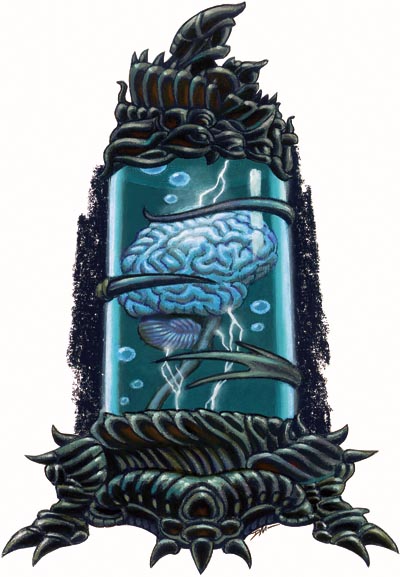 Tiny Undead
Hit Dice: 3d12 (19 hp)
Initiative: +2
Speed: Fly 30 ft. (8 squares) (good)
Armor Class: 13 (+2 Dex, +1 deflection), touch 13, flat-footed 11
Base Attack/Grapple:—/—
Attack:—
Full Attack:—
Space/Reach: 1 ft./—
Special Attacks: Mind thrust, psionics, rebuke undead 6/day (+5, 2d6+6, 3rd)
Special Qualities: Blindsight 60 ft., darkvision 60 ft., madness, telepathy, undead traits, +4 turn resistance
Saves: Fort +1, Ref +3, Will +6
Abilities: Str —, Dex 14, Con —, Int 16, Wis 12, Cha 16
Skills: Bluff +9, Diplomacy +9, Knowledge (history) +9, Knowledge (psionics) +9, Knowledge (religion) +9, Listen +9, Spot +9
Feats: Alertness, Iron Will
Environment: Any
Organization: Solitary
Challenge Rating: 4
Treasure: None
Alignment: Usually neutral evil
Advancement: 4–9 HD (Tiny)
Level Adjustment:—
Tiny Undead
Hit Dice: 3d12 (19 hp)
Initiative: +2
Speed: Fly 30 ft. (8 squares) (good)
Armor Class: 13 (+2 Dex, +1 deflection), touch 13, flat-footed 11
Base Attack/Grapple:—/—
Attack:—
Full Attack:—
Space/Reach: 1 ft./—
Special Attacks: Mind thrust, psionics, rebuke undead 6/day (+5, 2d6+6, 3rd)
Special Qualities: Blindsight 60 ft., darkvision 60 ft., madness, telepathy, undead traits, +4 turn resistance
Saves: Fort +1, Ref +3, Will +6
Abilities: Str —, Dex 14, Con —, Int 16, Wis 12, Cha 16
Skills: Bluff +9, Diplomacy +9, Knowledge (history) +9, Knowledge (psionics) +9, Knowledge (religion) +9, Listen +9, Spot +9
Feats: Alertness, Iron Will
Environment: Any
Organization: Solitary
Challenge Rating: 4
Treasure: None
Alignment: Usually neutral evil
Advancement: 4–9 HD (Tiny)
Level Adjustment:—
Something gray and shriveled sloshes within a grimy glass canister—a disembodied brain afloat in alchemical preservatives.
The brain in a jar is a masterpiece of preservation—but where alchemical preservatives leave off, necromancy picks up. An animate brain in a jar is, in truth, an undead creature. Additionally, possibly because it is free of the need to worry about controlling and animating an entire body, a brain in a jar possesses potent mental powers.
Of course, merely removing the brain of a zombie or some other undead creature and storing it in alchemical preservatives is not enough to create an undead brain with psionic ability. The ritual of extraction, the spells of formulation, and the alchemical recipes of preservation are closely guarded secrets held by only a few master necromancers.
The creation of a brain in a jar is difficult and fraught with danger, because once its mental powers are fully developed, this undead creature is adept at controlling the thoughts and minds of other creatures, especially living creatures. It is not unknown for a brain in a jar to take control over the necromancer who created it.
A brain in a jar weighs about 25 pounds, which includes the weight of the glass canister and the preservative fluids.
A brain in a jar can speak telepathically to any creature within 100 feet that has a language.
COMBAT
A brain in a jar prefers control to direct combat, since brains in fragile glass jars can’t stand too much jostling. However, when it can’t stay completely clear of combat, it seeks to put off aggressors with its mind thrust ability.
Mind Thrust (Su): A brain in a jar can spend a standard action to deliver a massive assault on the thought pathways of any one creature, undermining its intellect. This mind thrust deals 2d10 points of damage to any target creature that fails a DC 14 Will save. The save DC is Charisma-based.
Madness (Su): Anyone targeting a brain in a jar with a thought detection, mind control, or any sort of telepathic or psionic ability that makes direct contact with its tortured mind takes 1d4 points of Wisdom damage.
Psionics (Sp): 3/day—suggestion (DC 16), telekinesis (DC 18); 1/day—dominate person (DC 18). Manifester level 10th. The save DCs are Charisma-based.
Rebuke Undead (Su): A brain in a jar can rebuke or command undead as a cleric of the same level as the brain’s HD.
CARCASS EATER |
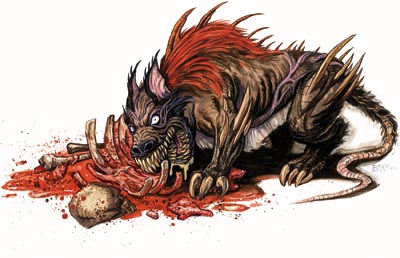 Small Animal
Hit Dice: 1d8+3 (7 hp)
Initiative: +3
Speed: 30 ft. (6 squares), burrow 10 ft.
Armor Class: 15 (+1 size, +3 Dex, +1 natural), touch 14, flatfooted 12
Base Attack/Grapple: +0/–5
Attack: Bite +4 melee (1d4–1)
Full Attack: 2 claws +4 melee (1d2–1) and bite –1 melee (1d4–1)
Space/Reach: 5 ft./5 ft.
Special Attacks: Blood frenzy
Special Qualities: Low-light vision, scent
Saves: Fort +5, Ref +5, Will +1
Abilities: Str 8, Dex 17, Con 17, Int 2, Wis 12, Cha 6
Skills: Hide +7, Listen +3, Spot +3
Feats: Track, Weapon Finesse
Environment: Temperate forests
Organization: Solitary, pair, or throng (6–9)
Challenge Rating: 1/2
Advancement: 2 HD (Small)
Level Adjustment:—
Small Animal
Hit Dice: 1d8+3 (7 hp)
Initiative: +3
Speed: 30 ft. (6 squares), burrow 10 ft.
Armor Class: 15 (+1 size, +3 Dex, +1 natural), touch 14, flatfooted 12
Base Attack/Grapple: +0/–5
Attack: Bite +4 melee (1d4–1)
Full Attack: 2 claws +4 melee (1d2–1) and bite –1 melee (1d4–1)
Space/Reach: 5 ft./5 ft.
Special Attacks: Blood frenzy
Special Qualities: Low-light vision, scent
Saves: Fort +5, Ref +5, Will +1
Abilities: Str 8, Dex 17, Con 17, Int 2, Wis 12, Cha 6
Skills: Hide +7, Listen +3, Spot +3
Feats: Track, Weapon Finesse
Environment: Temperate forests
Organization: Solitary, pair, or throng (6–9)
Challenge Rating: 1/2
Advancement: 2 HD (Small)
Level Adjustment:—
This gore-streaked, four-footed animal seems like a cross between a overlarge rat and a wolf, though even that can’t explain the extraordinary size of its toothy jaws.
Carcass eaters are most often found digging up fresh graves for food or, where opportunity is less available, hunting the night for prey.
An adult carcass eater is 3 to 4 feet long and weighs 65 to 75 pounds.
COMBAT
Carcass eaters attack with their sharp claws and teeth.
Blood Frenzy (Ex): A carcass eater that deals damage in combat against a living creature scents blood, which causes it to fly into a frenzy the following round. While in a blood frenzy, a carcass eater gains +4 to Strength, +4 to Constitution, and –2 to Armor Class. Sensing its victim’s death, the carcass eater claws and bites until its opponent is brought to negative hit points, at which time the creature immediately gains an additional bite attack against its fallen foe. This attack automatically hits, dealing 1d4+1 points of damage (which takes into account the +4 Strength bonus). A carcass eater cannot end its rage voluntarily.
Skills: A carcass eater has a +4 racial bonus on Hide checks.
CINDERSPAWN |
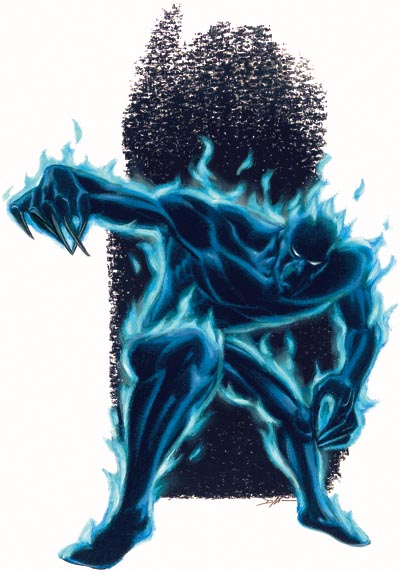 Large Undead (Fire)
Hit Dice: 10d12 (65 hp)
Initiative: +5
Speed: 50 ft. (10 squares)
Armor Class: 17 (–1 size, +5 Dex, +3 natural), touch 14, flatfooted 12
Base Attack/Grapple: +5/+10
Attack: Touch +9 melee (2d6 cold plus 1d6 Cha drain)
Full Attack: Touch +9 melee (2d6 cold plus 1d6 Cha drain)
Space/Reach: 10 ft./10 ft.
Special Attacks: Charisma drain
Special Qualities: Darkvision 60 ft., elemental turning vulnerability, frostfire shield, immunity to fire, inescapable craving, undead traits, vulnerability to cold
Saves: Fort +3, Ref +8, Will +7
Abilities: Str 12, Dex 21, Con —, Int 11, Wis 11, Cha 17
Skills: Jump +26, Listen +13, Move Silently +18, Spot +13
Feats: Dodge, Mobility, Spring Attack, Weapon Finesse
Environment: Any
Organization: Solitary, pair, or gang (3–5)
Challenge Rating: 6
Treasure: None
Alignment: Always chaotic evil
Advancement: 11–20 HD (Large); 16–30 HD (Huge)
Level Adjustment: +4
Large Undead (Fire)
Hit Dice: 10d12 (65 hp)
Initiative: +5
Speed: 50 ft. (10 squares)
Armor Class: 17 (–1 size, +5 Dex, +3 natural), touch 14, flatfooted 12
Base Attack/Grapple: +5/+10
Attack: Touch +9 melee (2d6 cold plus 1d6 Cha drain)
Full Attack: Touch +9 melee (2d6 cold plus 1d6 Cha drain)
Space/Reach: 10 ft./10 ft.
Special Attacks: Charisma drain
Special Qualities: Darkvision 60 ft., elemental turning vulnerability, frostfire shield, immunity to fire, inescapable craving, undead traits, vulnerability to cold
Saves: Fort +3, Ref +8, Will +7
Abilities: Str 12, Dex 21, Con —, Int 11, Wis 11, Cha 17
Skills: Jump +26, Listen +13, Move Silently +18, Spot +13
Feats: Dodge, Mobility, Spring Attack, Weapon Finesse
Environment: Any
Organization: Solitary, pair, or gang (3–5)
Challenge Rating: 6
Treasure: None
Alignment: Always chaotic evil
Advancement: 11–20 HD (Large); 16–30 HD (Huge)
Level Adjustment: +4
This tall, gaunt, coal-black humanoid flickers with a blue-white flame. Its bright yellow eyes gleam with menace.
Cinderspawn are burnt-out undead remnants of creatures of elemental fire. They hate living creatures for their warmth and seek to destroy all such beings. Like a fire elemental, a cinderspawn cannot enter water or any other nonflammable liquid. A body of water is an impassable barrier for a cinderspawn unless the creature can step or jump over it.
A cinderspawn stands 12 feet tall and weighs 200 pounds.
Cinderspawn speak Ignan.
COMBAT
A cinderspawn chooses targets carefully, using its Mobility and Spring Attack feats to reach vulnerable opponents that might otherwise be protected by comrades.
Charisma Drain (Su): Living creatures hit by a cinderspawn’s touch attack must make a DC 18 Fortitude save or take 1d6 points of Charisma drain. (Creatures with the fire subtype take a –4 penalty on this save.) When a cinderspawn drains a victim’s Charisma, it gains 5 temporary hit points, no matter how many points it drains. These temporary hit points last for up to 1 hour. The save DC is Charisma-based.
Elemental Turning Vulnerability (Ex): A character who can turn undead and also turn fire creatures gains a +2 bonus on turning checks to turn a cinderspawn. A character who can rebuke undead and also rebuke fire creatures gains a +2 bonus on turning checks to rebuke a cinderspawn.
Frostfire Shield (Su): Any creature striking a cinderspawn with a natural attack or a melee weapon (except for reach weapons) takes 1d6 points of cold damage as the cinderspawn drains its body heat.
Inescapable Craving: A cinderspawn has an inescapable craving (see the Undead Metabolism section in Chapter 1) for Charisma, which it satisfies by using its Charisma drain
ability.
CORPSE RAT SWARM |
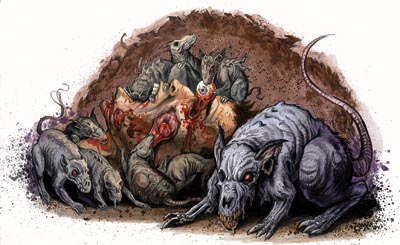 Tiny Undead (Swarm)
Hit Dice: 8d12 (52 hp)
Initiative: +1
Speed: 15 ft. (3 squares), climb 15 ft.
Armor Class: 13 (+2 size, +1 Dex), touch 13, flatfooted 12
Base Attack/Grapple: +4/—
Attack: Swarm (1d6 plus disease)
Full Attack: Swarm (1d6 plus disease)
Space/Reach: 10 ft./0 ft.
Special Attacks: Disease, distraction
Special Qualities: Damage reduction 5/ slashing, darkvision 60 ft., swarm traits, undead traits
Saves: Fort +2, Ref +3, Will +6
Abilities: Str 4, Dex 13, Con —, Int —, Wis 10, Cha 1
Skills:—
Feats:—
Environment: Any
Organization: Solitary, pack (2–4 swarms), or infestation (7–12 swarms)
Challenge Rating: 4
Treasure: None
Alignment: Always neutral evil
Advancement: None
Level Adjustment:—
Tiny Undead (Swarm)
Hit Dice: 8d12 (52 hp)
Initiative: +1
Speed: 15 ft. (3 squares), climb 15 ft.
Armor Class: 13 (+2 size, +1 Dex), touch 13, flatfooted 12
Base Attack/Grapple: +4/—
Attack: Swarm (1d6 plus disease)
Full Attack: Swarm (1d6 plus disease)
Space/Reach: 10 ft./0 ft.
Special Attacks: Disease, distraction
Special Qualities: Damage reduction 5/ slashing, darkvision 60 ft., swarm traits, undead traits
Saves: Fort +2, Ref +3, Will +6
Abilities: Str 4, Dex 13, Con —, Int —, Wis 10, Cha 1
Skills:—
Feats:—
Environment: Any
Organization: Solitary, pack (2–4 swarms), or infestation (7–12 swarms)
Challenge Rating: 4
Treasure: None
Alignment: Always neutral evil
Advancement: None
Level Adjustment:—
Leaving a stinking trail of blood and rotting entrails, the horde of tiny rat corpses squirms and squeals toward its victims.
Like a bone rat swarm, a corpse rat swarm is made up of countless undead rats. These, however, are closer to zombies than skeletons, with hunks of rotting flesh still hanging on their bones. They are even more disease-ridden than a normal rat swarm, and every bit as hungry for flesh.
COMBAT
A corpse rat swarm seeks to engulf and devour any living prey it encounters. A corpse rat swarm deals 1d6 points of damage to any creature whose space it occupies at the end of its move.
Disease (Ex): Filth fever—swarm attack, Fortitude DC 16, incubation period 1d3 days, damage 1d3 Dex and 1d3 Con. The save DC is Constitution-based and includes a +2 racial bonus.
Distraction (Ex): Any living creature that begins its turn with a corpse rat swarm in its space must succeed on a DC 15 Fortitude save or be nauseated for 1 round. The save DC is Constitution-based.
CRYPT CHANTER |
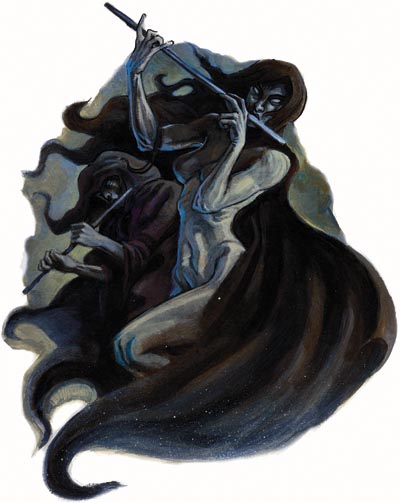 Medium Undead (Incorporeal)
Hit Dice: 7d12 (45 hp)
Initiative: +8
Speed: 30 ft. (6 squares), fly 30 ft. (perfect)
Armor Class: 19 (+4 Dex, +5 deflection), touch 19, flatfooted 15
Base Attack/Grapple: +3/—
Attack: Incorporeal touch +6 melee (1d8)
Full Attack: Incorporeal touch +6 melee (1d8)
Space/Reach: 5 ft./5 ft.
Special Attacks: Draining melody, create spawn
Special Qualities: Darkvision 60 ft., daylight powerlessness, incorporeal traits, undead traits, +2 turn resistance
Saves: Fort +2, Ref +6, Will +7
Abilities: Str —, Dex 18, Con —, Int 14, Wis 14, Cha 20
Skills: Hide +14, Intimidate +13, Listen +14, Perform (sing) +14, Search +12, Spot +14
Feats: Alertness, Blind-Fight, Improved Initiative
Environment: Any land and underground
Organization: Solitary, chorale (2–4), or choir (6–11)
Challenge Rating: 7
Treasure: None
Alignment: Always chaotic evil
Advancement: 8–17 HD (Medium)
Level Adjustment:—
Medium Undead (Incorporeal)
Hit Dice: 7d12 (45 hp)
Initiative: +8
Speed: 30 ft. (6 squares), fly 30 ft. (perfect)
Armor Class: 19 (+4 Dex, +5 deflection), touch 19, flatfooted 15
Base Attack/Grapple: +3/—
Attack: Incorporeal touch +6 melee (1d8)
Full Attack: Incorporeal touch +6 melee (1d8)
Space/Reach: 5 ft./5 ft.
Special Attacks: Draining melody, create spawn
Special Qualities: Darkvision 60 ft., daylight powerlessness, incorporeal traits, undead traits, +2 turn resistance
Saves: Fort +2, Ref +6, Will +7
Abilities: Str —, Dex 18, Con —, Int 14, Wis 14, Cha 20
Skills: Hide +14, Intimidate +13, Listen +14, Perform (sing) +14, Search +12, Spot +14
Feats: Alertness, Blind-Fight, Improved Initiative
Environment: Any land and underground
Organization: Solitary, chorale (2–4), or choir (6–11)
Challenge Rating: 7
Treasure: None
Alignment: Always chaotic evil
Advancement: 8–17 HD (Medium)
Level Adjustment:—
A lone, wavering figure begins a song. The haunting melody echoes through the air, calling for you to dance. The music makes your soul shrivel, but it also makes you smile. How can something be so awful and so wonderful at the same time?
A crypt chanter’s voice is the perfect horror, at once compelling and dreadful. These undead creatures sometimes appear to be playing spectral viols, flutes, drums, or any other instruments they choose, varying from chanter to chanter.
As incorporeal creatures, crypt chanters are weightless.
A crypt chanter never speaks directly, though it may give instructions or provide answers within the lyrics of its music (usually in Common, sometimes Abyssal).
COMBAT
A crypt chanter’s strength and shield is its music. A crypt chanter seeks to snare its victims with its music, and then drain them of life with the same melody. If threatened, a crypt chanter retreats into a nearby wall or other handy physical barrier.
Create Spawn (Su): Any humanoid slain by a crypt chanter through its draining melody (see below) becomes a crypt chanter 1d4 rounds later. Spawn are under the command of the crypt chanter that created them and remain enslaved until its destruction. They do not possess any of the abilities they had in life.
Draining Melody (Su): A crypt chanter constantly sings, creating a magically charged allure. All creatures within 60 feet of a crypt chanter must make a DC 18 Will save or stand dazed as long as the music continues. This is a sonic, mind-affecting, compulsion effect.
Beginning on the round after becoming dazed, creatures that failed the first saving throw must make a second saving throw (same DC) to avoid being affected as if by the enthrall spell (see page 227 of the Player’s Handbook). Enthralled victims also begin to gain 1d2 negative levels per round while the song continues, as long as they remain within range. If a creature gains a number of negative levels at least equal to its Hit Dice, it dies and becomes a spawn.
When a crypt chanter bestows negative levels on a victim, it gains 5 temporary hit points for each negative level bestowed. These temporary hit points last for up to 1 hour.
Creatures that successfully save upon hearing a crypt chanter’s music cannot be affected by that crypt chanter’s music again unless the chanter ceases singing for 1 full round (releasing all those it previously held in thrall) and begins a new song. The save DC is Charisma-based.
Daylight Powerlessness (Ex): A crypt chanter is utterly powerless in natural sunlight (not merely a daylight spell) and flees from it.
DEATHLOCK |
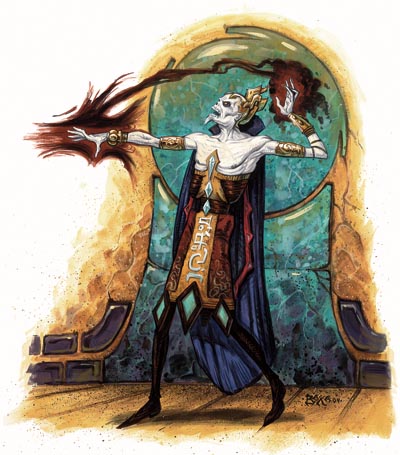 Medium Undead
Hit Dice: 3d12 (19 hp)
Initiative: +6
Speed: 30 ft. (6 squares)
Armor Class: 13 (+2 Dex, +1 natural), touch 12, flat-footed 11
Base Attack/Grapple: +1/+1
Attack: Bite +1 melee (1d4)
Full Attack: Bite +1 melee (1d4)
Space/Reach: 5 ft./5 ft.
Special Attacks: Spell-like abilities
Special Qualities: Darkvision 60 ft., undead traits, +2 turn resistance
Saves: Fort +1, Ref +3, Will +4
Abilities: Str 11, Dex 15, Con —, Int 14, Wis 13, Cha 14
Skills: Concentration +6, Hide +8, Knowledge (arcana) +8, Listen +9, Spellcraft +8, Spot +9
Feats: Alertness, Improved Initiative
Environment: Any
Organization: Solitary, trio, or college (5–9)
Challenge Rating: 3
Treasure: Standard
Alignment: Usually neutral evil
Advancement: By character class
Level Adjustment: +3
Medium Undead
Hit Dice: 3d12 (19 hp)
Initiative: +6
Speed: 30 ft. (6 squares)
Armor Class: 13 (+2 Dex, +1 natural), touch 12, flat-footed 11
Base Attack/Grapple: +1/+1
Attack: Bite +1 melee (1d4)
Full Attack: Bite +1 melee (1d4)
Space/Reach: 5 ft./5 ft.
Special Attacks: Spell-like abilities
Special Qualities: Darkvision 60 ft., undead traits, +2 turn resistance
Saves: Fort +1, Ref +3, Will +4
Abilities: Str 11, Dex 15, Con —, Int 14, Wis 13, Cha 14
Skills: Concentration +6, Hide +8, Knowledge (arcana) +8, Listen +9, Spellcraft +8, Spot +9
Feats: Alertness, Improved Initiative
Environment: Any
Organization: Solitary, trio, or college (5–9)
Challenge Rating: 3
Treasure: Standard
Alignment: Usually neutral evil
Advancement: By character class
Level Adjustment: +3
Skeletally thin, this figure wears a dramatic cloak fringed with magical sigils. Its cadaverous eyes sizzle with cursed power, and deadly spells dance on its fingertips.
Deathlocks are undead born of the corpses of powerful spellcasters whose remains are so charged with magic that they are unable to lie quiet in the grave. Animate, but shorn of the spirit that once ruled their forms, deathlocks seek to bring all those they meet into an intimate embrace with death. Only their knowledge of spellcasting remains, though twisted and changed.
Sometimes deathlocks retain a single shred of memory from their former spirits. If the recollection was dear to the spirit that once inhabited the now shriveled and blasted body of the deathlock, the creature usually seeks out the source of that memory, hoping to destroy it, compromise it, or undo the deeds associated with it.
Deathlocks stand between 5-1/2 and 6-1/2 feet tall and weigh between 100 and 120 pounds.
Deathlocks speak Common, Abyssal, and Infernal.
COMBAT
A deathlock prefers to use its spell-like abilities from a distance, disdaining melee. Thus, it can also use inflict minor wounds to heal itself.
Spell Like Abilities: At will—detect magic, inflict minor wounds (DC 13), read magic; 3/day—cause fear (DC 13), magic missile, summon monster I; 2/day—death knell (DC 14), ghoul glyph† (DC 14). Caster level equals the deathlock’s HD. The save DCs are Charisma-based. †New spell; see page 66.
DESICCATOR |
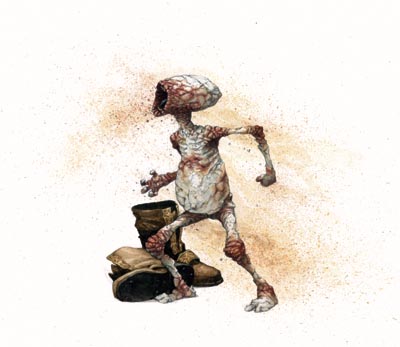 Small Undead (Water)
Hit Dice: 4d12 (26 hp)
Initiative: +5
Speed: 20 ft. (4 squares), swim 60 ft.
Armor Class: 15 (+1 size, +1 Dex, +3 natural), touch 12, flatfooted 14
Base Attack/Grapple: +2/+1
Attack: Slam +6 melee (1d6 plus fatigue)
Full Attack: Slam +6 melee (1d6 plus fatigue)
Space/Reach: 5 ft./5 ft.
Special Attacks: Desiccating breath, fatiguing touch
Special Qualities: Darkvision 60 ft., elemental turning vulnerability, inescapable craving, undead traits
Saves: Fort +1, Ref +2, Will +4
Abilities: Str 16, Dex 12, Con —, Int 8, Wis 11, Cha 13
Skills: Listen +7, Search +7, Spot +7
Feats: Ability Focus (desiccating breath), Improved Initiative
Environment: Any
Organization: Solitary or gang (2–5)
Challenge Rating: 2
Treasure: None
Alignment: Always neutral evil
Advancement: 5–7 HD (Medium), 8–12 HD (Large)
Level Adjustment: +3
Small Undead (Water)
Hit Dice: 4d12 (26 hp)
Initiative: +5
Speed: 20 ft. (4 squares), swim 60 ft.
Armor Class: 15 (+1 size, +1 Dex, +3 natural), touch 12, flatfooted 14
Base Attack/Grapple: +2/+1
Attack: Slam +6 melee (1d6 plus fatigue)
Full Attack: Slam +6 melee (1d6 plus fatigue)
Space/Reach: 5 ft./5 ft.
Special Attacks: Desiccating breath, fatiguing touch
Special Qualities: Darkvision 60 ft., elemental turning vulnerability, inescapable craving, undead traits
Saves: Fort +1, Ref +2, Will +4
Abilities: Str 16, Dex 12, Con —, Int 8, Wis 11, Cha 13
Skills: Listen +7, Search +7, Spot +7
Feats: Ability Focus (desiccating breath), Improved Initiative
Environment: Any
Organization: Solitary or gang (2–5)
Challenge Rating: 2
Treasure: None
Alignment: Always neutral evil
Advancement: 5–7 HD (Medium), 8–12 HD (Large)
Level Adjustment: +3
This small, salt-encrusted humanoid figure looks parched and gasping. Around it, a dry, hot breeze seems to blow from nowhere.
Desiccators are the dried-out undead remnants of creatures of elemental water. They long to quench their tremendous thirst with the precious fluids of living creatures.
Thanks to their withered forms, desiccators are sometimes mistaken for mummies, although they wear none of the wrappings common to those creatures. Cursed to remain forever bereft of the watery form it had in life, the desiccator envies and despises all living things.
Most desiccators stand about 4 feet tall but weigh only 30 to 40 pounds.
Desiccators speak Aquan.
COMBAT
A desiccator opens combat with its breath weapon, seeking to weaken opponents’ resistance to its fatiguing touch.
Desiccating Breath (Su): 15-foot cone of desiccating air every 1d4 rounds, damage 1 Con, Fortitude DC 15 negates. (Creatures with the water subtype take a –4 penalty on this save.) The save DC is Charisma-based and includes a +2 bonus from the Ability Focus feat.
Fatiguing Touch (Su): The slam of a desiccator, in addition to dealing 1d8 points of damage, makes living creatures fatigued. A DC 13 Fortitude save negates the fatigue but not the damage. (Creatures with the water subtype take a –4 penalty on this save.) If the victim fails the save, the desiccator also gains 5 temporary hit points, which last for up to 1 hour. A creature already fatigued cannot become exhausted as a result of this touch. The save DC is Charisma-based.
Elemental Turning Vulnerability (Ex): A character who can turn undead and also turn water creatures gains a +2 bonus on turning checks to turn a desiccator. A character who can rebuke undead and also rebuke water creatures gains a +2 bonus on turning checks to rebuke a desiccator.
Inescapable Craving: A desiccator has an inescapable craving (see the Undead Metabolism section in Chapter 1) for water, which it absorbs by using its fatiguing touch ability.
DIRE MAGGOT |
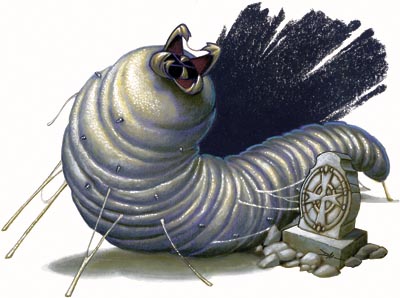 Small Vermin
Hit Dice: 6d8+6 (33 hp)
Initiative: +2
Speed: 40 ft. (8 squares), climb 40 ft.
Armor Class: 16 (–2 size, +2 Dex, +6 natural), touch 10, flat-footed 14
Base Attack/Grapple: +4/+15
Attack: Bite +3 melee (1d8+2 plus paralytic saliva)
Full Attack: Bite +3 melee (1d8+2 plus paralytic saliva)
Space/Reach: 15 ft./10 ft.
Special Attacks: Paralytic saliva
Special Qualities: Darkvision 60 ft., vermin traits
Saves: Fort +6, Ref +4, Will +2
Abilities: Str 13, Dex 15, Con 12, Int —, Wis 10, Cha 2
Skills: Climb +11, Hide +2, Spot +4
Feats:—
Environment: Underground
Organization: Solitary or slaughter (2–5)
Challenge Rating: 2
Advancement: 7–11 HD (Small)
Level Adjustment:—
Small Vermin
Hit Dice: 6d8+6 (33 hp)
Initiative: +2
Speed: 40 ft. (8 squares), climb 40 ft.
Armor Class: 16 (–2 size, +2 Dex, +6 natural), touch 10, flat-footed 14
Base Attack/Grapple: +4/+15
Attack: Bite +3 melee (1d8+2 plus paralytic saliva)
Full Attack: Bite +3 melee (1d8+2 plus paralytic saliva)
Space/Reach: 15 ft./10 ft.
Special Attacks: Paralytic saliva
Special Qualities: Darkvision 60 ft., vermin traits
Saves: Fort +6, Ref +4, Will +2
Abilities: Str 13, Dex 15, Con 12, Int —, Wis 10, Cha 2
Skills: Climb +11, Hide +2, Spot +4
Feats:—
Environment: Underground
Organization: Solitary or slaughter (2–5)
Challenge Rating: 2
Advancement: 7–11 HD (Small)
Level Adjustment:—
A four-foot-long dead-white segmented worm heaves into view. Eyeless, drooling stinking ichor from its clacking mandibles, the monstrosity resembles nothing so much as a maggot grown orders of magnitude too large.
A maggot is the worm-shaped larva of a fly, but a dire maggot is the larva of similarly monstrous flying vermin. While regular maggots are found in decaying matter, dire maggots are large, quick, and aggressive enough to seek out living prey for nourishment.
COMBAT
Dire maggots seek to paralyze their prey, though still-squirming prey is just as good to the mindless maggot.
Paralytic Saliva (Ex): A creature bitten by a dire maggot must make a DC 14 Fortitude save or be paralyzed for 1 round. The save DC is Constitution-based. Vermin Traits: A dire maggot is immune to all mind-affecting spells and abilities (charms, compulsions, phantasms, patterns, and morale effects). It also has darkvision out to 60 feet.
DREAM VESTIGE |
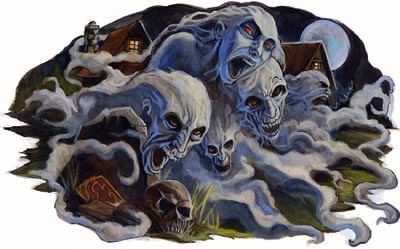 Huge Undead (Incorporeal)
Hit Dice: 17d12 (110 hp)
Initiative: +9
Speed: Fly 40 ft. (perfect)
Armor Class: 31 (–2 size, +5 Dex, +18 deflection), touch 31, flat-footed 26
Base Attack/Grapple: +8/+16
Attack: Tendril +15 melee touch (3d6 plus form consumption)
Full Attack: 4 tendrils +15 melee touch (3d6 plus form consumption)
Space/Reach: 15 ft./20 ft.
Special Attacks: Desecrating aura, form consumption, frightful presence
Special Qualities: Blindsight 120 ft., damage reduction 10/—, darkvision 60 ft., deflective aura, dream travel, incorporeal traits, inescapable craving, self spawn, spell resistance 28, undead traits
Saves: Fort +9, Ref +14, Will +19
Abilities: Str —, Dex 20, Con —, Int 18, Wis 20, Cha 20
Skills: Concentration +24, Diplomacy +6, Hide +16, Listen +25, Move Silently +24, Search +24, Sense Motive +25, Spellcraft +24, Spot +25, Survival +5 (+7 following tracks)
Feats: Combat Reflexes, Great Fortitude, Iron Will, Improved Initiative, Lightning Reflexes, Weapon Finesse
Environment: Any
Organization: Solitary
Challenge Rating: 16
Treasure: Standard
Alignment: Always chaotic evil
Advancement: 18–25 HD (Huge); 26–51 HD (Gargantuan)
Level Adjustment:—
Huge Undead (Incorporeal)
Hit Dice: 17d12 (110 hp)
Initiative: +9
Speed: Fly 40 ft. (perfect)
Armor Class: 31 (–2 size, +5 Dex, +18 deflection), touch 31, flat-footed 26
Base Attack/Grapple: +8/+16
Attack: Tendril +15 melee touch (3d6 plus form consumption)
Full Attack: 4 tendrils +15 melee touch (3d6 plus form consumption)
Space/Reach: 15 ft./20 ft.
Special Attacks: Desecrating aura, form consumption, frightful presence
Special Qualities: Blindsight 120 ft., damage reduction 10/—, darkvision 60 ft., deflective aura, dream travel, incorporeal traits, inescapable craving, self spawn, spell resistance 28, undead traits
Saves: Fort +9, Ref +14, Will +19
Abilities: Str —, Dex 20, Con —, Int 18, Wis 20, Cha 20
Skills: Concentration +24, Diplomacy +6, Hide +16, Listen +25, Move Silently +24, Search +24, Sense Motive +25, Spellcraft +24, Spot +25, Survival +5 (+7 following tracks)
Feats: Combat Reflexes, Great Fortitude, Iron Will, Improved Initiative, Lightning Reflexes, Weapon Finesse
Environment: Any
Organization: Solitary
Challenge Rating: 16
Treasure: Standard
Alignment: Always chaotic evil
Advancement: 18–25 HD (Huge); 26–51 HD (Gargantuan)
Level Adjustment:—
A mighty river of fog streams forward like an evil waterfall, swollen with storm and spray. Accompanying the shape is a susurrus of dreamlike voices that murmur, cry, and rail against some terrible fate. Slender tendrils of mist extend from the mass, patting and feeling for sustenance.
The original dream vestige was born from the nightmares of an entire city, as all of its citizens died in cursed sleep (a curse that some attribute to Orcus). Since then, that creature has spawned itself many times over.
A dream vestige is a hunter; it hunts for other creatures to incorporate into itself—mind and body, living or undead. Thus, even the undying have cause to fear a dream vestige, which preys on its own. It stalks prey on rooftops, behind walls, or under floors, unseen by its victims. A sudden visceral dread (its frightful presence ability) heralds the creature’s arrival, at which time the whispers, moans, and lamenting of its subsumed victims becomes audibly apparent.
A dream vestige understands the languages of all those who have been integrated into it, which essentially means it knows all the most prevalent languages.
COMBAT
A dream vestige uses its incorporeal tendrils to disrupt and crumble the minds and bodies of the living, seeking to draw ever more creatures into itself.
Desecrating Aura (Su): A dream vestige gives off a 20-footradius emanation of utter desecration, imbuing its surroundings with negative energy. This ability works much like a desecrate spell, except the vestige itself is treated as the shrine of an evil power. All undead within 20 feet of the dream vestige (including the creature itself) gain a +2 profane bonus on attack rolls, damage rolls, and saving throws, and +2 hit points per HD. (The dream vestige’s Hit Dice, attack, and save entries given here already include these profane bonuses.) Charisma checks made to turn undead within this area take a –6 penalty.
A dream vestige’s desecrating aura cannot be dispelled except by a dispel evil spell or similar effect. If the effect is dispelled, the dream vestige can resume it as a free action on its next turn. Its desecrating aura is suppressed if a dream vestige enters a consecrated or hallowed area, but the dream vestige’s presence also suppresses the consecrated or hallowed effect for as long as it remains in the area.
Form Consumption (Su): Each touch by a dream vestige’s tendril drains a portion of the victim’s mind (though nonintelligent or mindless creatures are immune to a dream vestige’s lascivious caresses). Each touch deals 1d4 points of Intelligence drain to the victim. When a dream vestige drains a victim’s Intelligence, it gains 5 temporary hit points, no matter how many points it drains. Temporary hit points gained in this way last for up to 1 hour. Should a dream vestige ever acquire a number of temporary hit points equal to its full normal hit points, it self spawns (see below).
At the beginning of a dream vestige’s subsequent action after a creature has been drained to 0 Intelligence, the victim’s body is automatically engulfed and dissolved by the dream vestige, leaving nothing behind, not even dust.
Frightful Presence (Su): A dream vestige can inspire terror by charging or attacking. Affected creatures must succeed on a DC 23 Will save or become shaken, remaining in that condition as long as they remain with 60 feet of the dream vestige. A creature that successfully saves cannot be affected by that dream vestige’s frightful presence for 24 hours. The save DC is Charisma-based.
Deflective Aura (Su): A dream vestige is protected by a powerful aura of dream energy. This special aura increases its AC deflection bonus by 13 (in addition to its incorporeal deflection bonus of +5), which is already factored into the statistics above.
Dream Travel (Su): A dream vestige can pull itself fully into the world of dreams, leaving behind the waking world, as a standard action. For every minute the vestige moves through the dream region, it travels 5 miles in the waking world. A dream vestige can also use this ability to travel across planar borders, should it desire. A dream vestige always knows where it will come out in the waking world.
Inescapable Craving: A dream vestige has an inescapable craving (see the Undead Metabolism section in Chapter 1) for bodies, which it satisfies by using its form consumption ability.
Self Spawn (Ex): When a dream vestige gains a number of temporary hit points equal to its full normal hit point total, it self spawns, splitting into two identical dream vestiges, each with a number of hit points equal to the original dream vestige’s full normal total.
ENTOMBER |
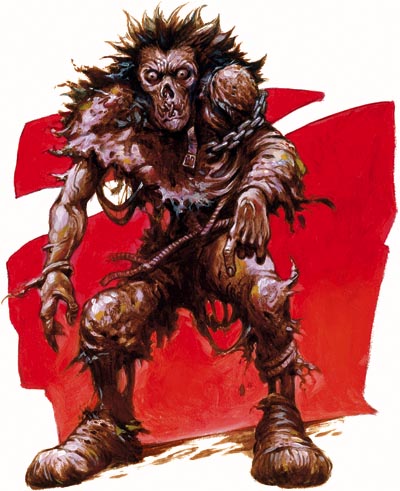 Medium Undead
Hit Dice: 8d12 (52 hp)
Initiative: +0
Speed: 30 ft. (6 squares), burrow 10 ft.
Armor Class: 21 (+11 natural), touch 10, flat-footed 21
Base Attack/Grapple: +4/+11
Attack: Slam +10 melee (1d6+9 plus entomb)
Full Attack: Slam +10 melee (1d6+9 plus entomb)
Space/Reach: 5 ft./5 ft.
Special Attacks: Entomb, exhume
Special Qualities: Damage reduction 5/silver, darkvision 60 ft., undead traits
Saves: Fort +4, Ref +4, Will +8
Abilities: Str 23, Dex 10, Con —, Int 6, Wis 14, Cha 15
Skills: Hide +7, Listen +8, Move Silently +7, Spot +8
Feats: Alertness, Great Fortitude, Lightning Reflexes
Environment: Any
Organization: Solitary, digger squad (2–4), or cemetery detail (6–10)
Challenge Rating: 5
Treasure: Standard
Alignment: Always lawful evil
Advancement: 9–16 HD (Medium); 17–24 HD (Large)
Level Adjustment:—
Medium Undead
Hit Dice: 8d12 (52 hp)
Initiative: +0
Speed: 30 ft. (6 squares), burrow 10 ft.
Armor Class: 21 (+11 natural), touch 10, flat-footed 21
Base Attack/Grapple: +4/+11
Attack: Slam +10 melee (1d6+9 plus entomb)
Full Attack: Slam +10 melee (1d6+9 plus entomb)
Space/Reach: 5 ft./5 ft.
Special Attacks: Entomb, exhume
Special Qualities: Damage reduction 5/silver, darkvision 60 ft., undead traits
Saves: Fort +4, Ref +4, Will +8
Abilities: Str 23, Dex 10, Con —, Int 6, Wis 14, Cha 15
Skills: Hide +7, Listen +8, Move Silently +7, Spot +8
Feats: Alertness, Great Fortitude, Lightning Reflexes
Environment: Any
Organization: Solitary, digger squad (2–4), or cemetery detail (6–10)
Challenge Rating: 5
Treasure: Standard
Alignment: Always lawful evil
Advancement: 9–16 HD (Medium); 17–24 HD (Large)
Level Adjustment:—
This shrunken and disfigured humanoid carcass moves under the power of its own animation, though the details of its shape are blurred beneath a coating of filth and grave dirt.
Entombers are undead animated by necromancers who prefer to leave the dirty work to their servants. The entombers are perfect for putting bodies in the ground, or bringing them out, depending on the needs of their masters. They usually inhabit cemeteries, catacombs, or other places where many corpses might be found. Unless specifically commanded otherwise, entombers treat all living creatures as subjects for their entombing power.
Entombers are filthy, streaked with dirt, and sometimes even bits of desiccated flesh (not their own), jewelry, and other small bits taken from the bodies they exhume or entomb. They stink of both carrion and embalming alchemical fluids. Closer scrutiny reveals their lips are sewn shut.
Most entombers are about 6 feet tall and weigh about 160 pounds.
Entombers understand Common, but their lips are sewn shut, so they cannot speak.
COMBAT
In melee combat, an entomber’sfist is a powerful weapon. However, the fear associated with entombers is more due to their ability to entomb foes with their attack.
Entomb (Su): Whenever an entomber succeeds on a slam attack, it can attempt to entomb its foe. The foe must make a DC 16 Reflex save or be pounded bodily into a shallow grave. The save DC is Charisma-based. This ability doesn’t work in locations with a basement or open level immediately below, nor can the creature entomb victims in magical, living, or animate materials, or materials with a hardness higher than 8.
The upthrust bulge of cracked flooring material, earth, or stone reveals the location of the victim to compatriots. Two standard actions spent clearing away the broken flooring material reveals the entombed victim, who can use his or her next action to stand from a prone (and dusty) position. Attempting to rescue a friend in this way can provoke attacks of opportunity.
The victim is treated as if pinned by an opponent (the earth) with a grappling check of 20. Breaking free of first the “pin” and then the “grapple” allows the victim to stand from a prone position on his or her next round. If compatriots of the victim have partially cleared away the covering material, then the victim need only make a single check before standing from the prone position. Each round the victim spends fully or partially entombed is a round in which the victim suffocates (see Suffocation, page 304 of the Dungeon Master’s Guide).
Exhume (Su): When an entomber spends a standard action and touches the top of a grave or space where a creature is buried no deeper than 10 feet, the body immediately rises to the surface, leaving no hole or tunnel. A body is not harmed when brought to the surface in this manner.
ENTROPIC REAPER |
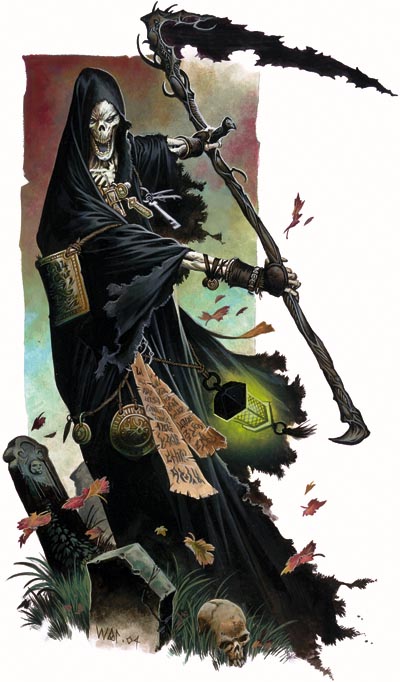 Medium Undead (Extraplanar, Chaotic)
Hit Dice: 19d12+19 (142 hp)
Initiative: +6
Speed: 30 ft. (6 squares)
Armor Class: 20 (+2 Dex, +8 natural), touch 12, flat-footed 18
Base Attack/Grapple: +9/+18
Attack: Large scythe +13 melee (2d6+18 plus entropic blade/ 19–20/×4)*
Full Attack: Large scythe +13/+8 melee (2d6+18 plus entropic blade/19–20/×4)*
Space/Reach: 5 ft./5 ft.
Special Attacks: Entropic blade, spell-like abilities
Special Qualities: Damage reduction 10/cold iron and lawful, darkvision 60 ft., fast healing 10, master of the scythe, spell resistance 22, undead traits
Saves: Fort +17, Ref +8, Will +13
Abilities: Str 29, Dex 14, Con —, Int 11, Wis 20, Cha 15
Skills: Concentration +23, Knowledge (planes) +23, Listen +26, Spot +26
Feats: Combat Reflexes, Improved Critical (scythe), Improved Toughness†, Power Attack, Cleave, Improved Initiative, Whirlwind Attack
Environment: Ever-Changing Chaos of Limbo
Organization: Solitary
Challenge Rating: 12
Treasure: Standard
Alignment: Always chaotic evil
Advancement: 20–35 HD (Medium)
Level Adjustment:— *Includes adjustments for Power Attack feat.
Medium Undead (Extraplanar, Chaotic)
Hit Dice: 19d12+19 (142 hp)
Initiative: +6
Speed: 30 ft. (6 squares)
Armor Class: 20 (+2 Dex, +8 natural), touch 12, flat-footed 18
Base Attack/Grapple: +9/+18
Attack: Large scythe +13 melee (2d6+18 plus entropic blade/ 19–20/×4)*
Full Attack: Large scythe +13/+8 melee (2d6+18 plus entropic blade/19–20/×4)*
Space/Reach: 5 ft./5 ft.
Special Attacks: Entropic blade, spell-like abilities
Special Qualities: Damage reduction 10/cold iron and lawful, darkvision 60 ft., fast healing 10, master of the scythe, spell resistance 22, undead traits
Saves: Fort +17, Ref +8, Will +13
Abilities: Str 29, Dex 14, Con —, Int 11, Wis 20, Cha 15
Skills: Concentration +23, Knowledge (planes) +23, Listen +26, Spot +26
Feats: Combat Reflexes, Improved Critical (scythe), Improved Toughness†, Power Attack, Cleave, Improved Initiative, Whirlwind Attack
Environment: Ever-Changing Chaos of Limbo
Organization: Solitary
Challenge Rating: 12
Treasure: Standard
Alignment: Always chaotic evil
Advancement: 20–35 HD (Medium)
Level Adjustment:— *Includes adjustments for Power Attack feat.
A skeletal being cloaked in a great black robe and head-concealing hood holds a large scythe in both hands. The head of the scythe is an absence in space, a blade-shaped hole in reality that draws in the light around it.
Entropic reapers are undead that arise in Limbo. They enforce the twisted edicts of chaotic beings that decree the death of lawful creatures (though an entropic reaper is not particular about the alignments of the creatures it brings low). Though originating in Limbo, entropic reapers spend much of their time in the Material Plane, seeking to apply their entropic scythes to the necks of the living.
Entropic reapers stand about 6-1/2 feet tall and weigh about 180 pounds.
Entropic reapers speak Common, Abyssal, and Celestial.
COMBAT
An entropic reaper uses its selfenhanced scythe to wreak terrible damage on those it decides must die (which includes most creatures it happens to meet).
The scythe an entropic reaper wields is treated as chaotic-aligned for the purpose of over coming damage reduction.
An entropic reaper normally attacks using its Power Attack feat, taking a –5 penalty on its attack rolls and gaining a +5 bonus on damage rolls.
Entropic Blade (Su): An entropic reaper confers the entropic blade property upon any weapon it wields—usually a normal scythe. An entropic blade functions in all ways like the kind of weapon it is, with the following addition. Any time the entropic reaper successfully deals damage with its entropic blade, the victim must make a DC 21 Fortitude save or be overcome with searing pain, as the victim’s form melts, flows, writhes, and boils. During this entropic state, the victim cannot cast spells or use magic items, and it attacks blindly, unable to distinguish friend from foe (–4 penalty on attack rolls and a 50% miss chance, regardless of the attack roll). Each round spent in this entropic state, the victim takes 1 point of Wisdom drain from mental shock. If the victim’s Wisdom score falls to 0, it discorporates into nothingness.
A victim can gain control over itself by taking a standard action to attempt a DC 21 Charisma check. Success renders the victim immune from the entropic state for 1 minute. On a failure, the victim can still repeat this check each round until successful. The entropic state is not a disease or a curse, so it is hard to remove. A shapechange or stoneskin spell does not cure an afflicted creature but fixes its state for the duration of the spell. A restoration, heal, or greater restoration spell removes the affliction (though a separate restoration is necessary to restore any drained points of Wisdom). The save DC is Charisma-based.
Master of the Scythe (Su): The entropic reaper is a master of the scythe, and gains the ability to wield a weapon one size larger than normal. It also treats the scythe as if it were a mighty cleaving weapon, which allows it to make one additional cleave attempt in a round.
Spell Like Abilities: 1/day—plane shift. Caster level equals the entropic reaper’s HD. The save DCs are Charisma-based.
EVOLVED UNDEAD |
When an intelligent undead creature survives for 100 years or more (or when the DM decides to create an undead monster with a twist), there is a 1% chance that its connection to the Negative Energy Plane grows more mature. When this “evolution” occurs, the undead gains this template. Each additional 100 years of existence affords an additional 1% chance of a more mature connection, plus an additional 1% chance for each previous evolution. For example, if an undead creature’s connection to the Negative Energy Plane evolved three times previously, it has a 4% chance to gain one more step of maturation the next time its age requires an evolution check. Every step of evolution means that the evolved undead template can be applied again to the undead creature (setting this template apart from most other templates, which can be applied only once).
SAMPLE EVOLVED UNDEAD
This example uses a wraith as the base creature.Evolved Wraith
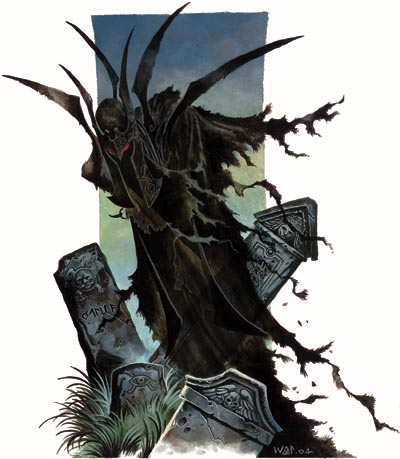 Medium Undead (Incorporeal)
Hit Dice: 5d12 (32 hp)
Initiative: +7
Speed: Fly 60 ft. (12 squares) (good)
Armor Class: 16 (+3 Dex, +3 deflection), touch 16, flat-footed 13
Base Attack/Grapple: +2/—
Attack: Incorporeal touch +5 melee (1d4 plus 1d6 Constitution drain)
Full Attack: Incorporeal touch +5 melee (1d4 plus 1d6 Constitution drain)
Space/Reach: 5 ft./5 ft.
Special Attacks: Constitution drain, create spawn
Special Qualities: Darkvision 60 ft., daylight powerlessness, fast healing 3, incorporeal traits, spell-like ability, undead traits, unnatural aura, +2 turn resistance
Saves: Fort +1, Ref +4, Will +6
Abilities: Str —, Dex 16, Con —, 14, Wis 14, Cha 17
Skills: Diplomacy +6, Hide +11, Intimidate +10, Listen +12, Search +10, Sense Motive +8, Spot +12, Survival +2 (+4 following tracks)
Feats: Alertness, Blind-Fight, Combat Reflexes, Improved Initiative
Environment: Any
Organization: Solitary, gang (2–5), or pack (6–11)
Challenge Rating: 6
Treasure: None
Alignment: Always lawful evil
Advancement: 6–10 HD (Medium)
Level Adjustment:—
Medium Undead (Incorporeal)
Hit Dice: 5d12 (32 hp)
Initiative: +7
Speed: Fly 60 ft. (12 squares) (good)
Armor Class: 16 (+3 Dex, +3 deflection), touch 16, flat-footed 13
Base Attack/Grapple: +2/—
Attack: Incorporeal touch +5 melee (1d4 plus 1d6 Constitution drain)
Full Attack: Incorporeal touch +5 melee (1d4 plus 1d6 Constitution drain)
Space/Reach: 5 ft./5 ft.
Special Attacks: Constitution drain, create spawn
Special Qualities: Darkvision 60 ft., daylight powerlessness, fast healing 3, incorporeal traits, spell-like ability, undead traits, unnatural aura, +2 turn resistance
Saves: Fort +1, Ref +4, Will +6
Abilities: Str —, Dex 16, Con —, 14, Wis 14, Cha 17
Skills: Diplomacy +6, Hide +11, Intimidate +10, Listen +12, Search +10, Sense Motive +8, Spot +12, Survival +2 (+4 following tracks)
Feats: Alertness, Blind-Fight, Combat Reflexes, Improved Initiative
Environment: Any
Organization: Solitary, gang (2–5), or pack (6–11)
Challenge Rating: 6
Treasure: None
Alignment: Always lawful evil
Advancement: 6–10 HD (Medium)
Level Adjustment:—
Combat
An evolved wraith attacks just like a normal wraith, with a few extra abilities.Constitution Drain (Su): Living creatures hit by an evolved wraith’s incorporeal touch attack must succeed on a DC 14 Fortitude save or take 1d6 points of Constitution drain. The save DC is Charisma-based. On each such successful attack, the wraith gains 5 temporary hit points that last for up to 1 hour.
Create Spawn (Su): Any humanoid slain by an evolved wraith becomes a wraith in 1d4 rounds. Its body remains intact and inanimate, but its spirit is torn free from its corpse and transformed. Spawn are under the command of the wraith that created them and remain enslaved until its death. They do not possess any of the abilities they had in life.
Daylight Powerlessness (Ex): Evolved wraiths are utterly powerless in natural sunlight (not merely a daylight spell) and flee from it.
Fast Healing (Ex): An evolved wraith heals 3 points of damage each round so long as it has at least 1 hit point. Spell-Like Ability: 1/day—haste (self only). Caster level 5th.
Unnatural Aura (Su): Animals, whether wild or domesticated, can sense the unnatural presence of an evolved wraith at a distance of 30 feet. They will not willingly approach nearer than that and panic if forced to do so; they remain panicked as long as they are within that range.
CREATING AN EVOLVED UNDEAD
“Evolved undead” is an acquired template that can be added to any undead with an Intelligence score (referred to hereafter as the base creature). An evolved undead uses all the base creature’s statistics and special abilities except as noted here. This template does not alter the creature’s type.
Note: Unlike most templates, an evolved undead can potentially acquire this template more than once, evolving more with each application.
Armor Class: The base creature’s natural armor bonus improves by 1. If the creature is incorporeal, its deflection bonus to AC improves by 1.
Special Attacks: An evolved undead retains all the special attacks of the base creature and gains one spell-like ability from the following list. You can choose this ability from the list below, or roll randomly. The spell-like ability gained herein can be used once per day. If the undead already has the indicated ability, it gains another use; if it already has the ability as an at-will ability, choose another ability. The spell-like ability has a caster level equal to the evolved undead’s HD (if the caster level is too low to cast the spell in question, choose another). The save DCs are Charisma-based:
| d12 | Spell-Like Ability |
|---|---|
| 1 | circle of death |
| 2 | cloudkill |
| 3 | cone of cold |
| 4 | confusion |
| 5 | contagion |
| 6 | creeping doom |
| 7 | greater dispel magic |
| 8 | greater invisibility |
| 9 | haste |
| 10 | hold monster |
| 11 | see invisibility |
| 12 | unholy blight |
Special Qualities: An evolved undead retains all the special qualities of the base creature and gains the one described below.
Fast Healing (Ex): An evolved undead heals 3 points of damage each round so long as it has at least 1 hit point.
Abilities: An evolved corporeal undead gains +2 Strength and +2 Charisma. An evolved incorporeal creature gains only +2 Charisma.
Organization: An evolved undead usually becomes a leader among those of its base kind.
Challenge Rating: Same as the base creature +1.
Level Adjustment: Same as the base creature +1.
FORSAKEN SHELL |
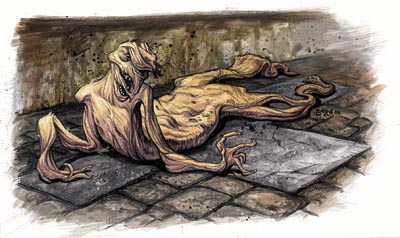 Medium Undead
Hit Dice: 14d12+14 (105 hp)
Initiative: +5
Speed: 30 ft. (6 squares), 15 ft. (burrow)
Armor Class: 17 (+1 Dex, +6 natural), touch 11, flat-footed 16
Base Attack/Grapple: +7/+12
Attack: Skin slap +7 melee (1d6+10)*
Full Attack: Skin slap +7 melee (1d6+10)*
Space/Reach: 5 ft./5 ft.
Special Attacks: Constrict, create spawn, improved grab
Special Qualities: Darkvision 60 ft., undead traits
Saves: Fort +4, Ref +7, Will +9
Abilities: Str 21, Dex 13, Con —, Int 11, Wis 10, Cha 10
Skills: Climb +13, Hide +22, Listen +11, Move Silently +18, Spot +15, Swim +9
Feats: Alertness, Improved Initiative, Improved Toughness†, Lightning Reflexes, Power Attack.
Environment: Any
Organization: Solitary, gang (2–4), or mob (2–4 plus 5–10 zombies)
Challenge Rating: 6
Treasure: Standard
Alignment: Always chaotic evil
Advancement: 15–30 HD (Medium)
Level Adjustment:— *Includes adjustments for Power Attack feat.
Medium Undead
Hit Dice: 14d12+14 (105 hp)
Initiative: +5
Speed: 30 ft. (6 squares), 15 ft. (burrow)
Armor Class: 17 (+1 Dex, +6 natural), touch 11, flat-footed 16
Base Attack/Grapple: +7/+12
Attack: Skin slap +7 melee (1d6+10)*
Full Attack: Skin slap +7 melee (1d6+10)*
Space/Reach: 5 ft./5 ft.
Special Attacks: Constrict, create spawn, improved grab
Special Qualities: Darkvision 60 ft., undead traits
Saves: Fort +4, Ref +7, Will +9
Abilities: Str 21, Dex 13, Con —, Int 11, Wis 10, Cha 10
Skills: Climb +13, Hide +22, Listen +11, Move Silently +18, Spot +15, Swim +9
Feats: Alertness, Improved Initiative, Improved Toughness†, Lightning Reflexes, Power Attack.
Environment: Any
Organization: Solitary, gang (2–4), or mob (2–4 plus 5–10 zombies)
Challenge Rating: 6
Treasure: Standard
Alignment: Always chaotic evil
Advancement: 15–30 HD (Medium)
Level Adjustment:— *Includes adjustments for Power Attack feat.
Roiling and coiling, this long, slender creature snakes forward. At first, it does seem like a snake, if strangely wide and looseskinned, but an instant later the creature is revealed for what it is—an evacuated but horribly animate humanoid skin that continues to slither onward in an unmistakably aggressive manner.
Forsaken shells are what they appear to be—the empty skins of past victims, purged of their bloody and visceral former contents. The loose skins possess an amazing strength and elasticity, driven by necromantic élan and a predatory nature that cannot be denied.
This creature’s ability to strip a skin from a victim and animate new versions of itself is terrible enough, but far worse is the accidental discovery of the creature’s depredations before uncovering the creature itself. When a forsaken shell skulks into a new area, it seeks to hide the evidence of its predation in out-of-the-way places such as little-opened closets or beneath piles of discarded supplies. Still, sometimes a telltale finger or toe peeking out from the obscuring barrier leads to the discovery of tangled, skinless bodies of fellow friends or family, their dead eyes reflecting their last silent screams.
Forsaken shells weigh about 20 to 30 pounds.
Forsaken shells do not speak, but they understand Common.
COMBAT
Forsaken shells are aggressive, but prefer to strike from secret against lone prey. However, even forsaken shells, despite their lack of form, can feel the need to exact vengeance upon someone who has harmed or merely threatened other forsaken shells, especially its spawn. When this happens, they become implacable enemies, willing to attack even large groups of opponents.
A forsaken shell normally attacks using its Power Attack feat, taking a –5 penalty on its attack rolls and gaining a +5 bonus on damage rolls.
Constrict (Ex): A forsaken shell deals 1d6+5 points of damage with a successful grapple check. Constricting uses the entire body of the creature, so it cannot take any move actions while constricting.
Create Spawn (Su): Creatures killed by a forsaken shell slough their skins after 1d4 rounds. These sloughed skins are new forsaken shells under the spawner’s control. These forsaken shells do not possess any of the abilities they had in life.
Improved Grab (Ex): To use this ability, a forsaken shell must successfully hit an opponent with its skin slap attack. It can then attempt to start a grapple as a free action without provoking attacks of opportunity. If it wins the grapple check, it establishes a hold and can constrict.
Skills: Forsaken shells have a +4 racial bonus on Hide checks (already figured into the statistics above), due to their ability to fold themselves into very small spaces.
GHOST BRUTE |
A ghost brute most often results from the same circumstances that caused its earthly companion or master to remain after death. It might be the mount of a betrayed paladin, the beloved pet of a child tragically killed, the scorched oak of a ghostly dryad, or a murdered druid’s animal companion. In most cases, laying the associated being to rest also puts an end to the ghost brute.
However, sometimes a bizarre circumstance might produce a ghost brute without an intelligent companion. For example, a forest suddenly obliterated by an evil magical attack might remain as a ghostly grove populated by lingering spirits not even completely aware of their own destruction.
SAMPLE GHOST BRUTE
This example uses a large riding dog as the base creature.Against Material Plane Opponents
Ghost Brute Hound
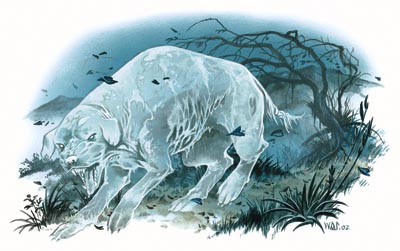 Medium Undead (Incorporeal, Augmented Animal)
Hit Dice: 2d12 (13 hp)
Initiative: +2
Speed: Fly 30 ft. (6 squares) (perfect) ArmorClass: 14 (+2 Dex, +2 deflection), touch 14, flat-footed 12
Base Attack/Grapple: +1/—
Attack: None
Full Attack: None Face/Reach: 5 ft./5 ft.
Special Attacks: Slavering doom
Special Qualities: Darkvision 60 ft., incorporeal traits, lowlight vision, manifestation, rejuvenation, scent, undead traits, +2 turn resistance
Saves: Fort +3, Ref +5, Will +1
Abilities: Str —, Dex 15, Con —, Int 2, Wis 12, Cha 15
Skills: Hide +8, Jump +4, Listen +13, Search +8, Spot +13, Swim +3, Survival +1 (+9 when tracking by scent)
Feats: Alertness, Track Climate/Terrain: Any land
Organization: Solitary
Challenge Rating: 3
Treasure: None
Alignment: Usually neutral
Advancement:—
Medium Undead (Incorporeal, Augmented Animal)
Hit Dice: 2d12 (13 hp)
Initiative: +2
Speed: Fly 30 ft. (6 squares) (perfect) ArmorClass: 14 (+2 Dex, +2 deflection), touch 14, flat-footed 12
Base Attack/Grapple: +1/—
Attack: None
Full Attack: None Face/Reach: 5 ft./5 ft.
Special Attacks: Slavering doom
Special Qualities: Darkvision 60 ft., incorporeal traits, lowlight vision, manifestation, rejuvenation, scent, undead traits, +2 turn resistance
Saves: Fort +3, Ref +5, Will +1
Abilities: Str —, Dex 15, Con —, Int 2, Wis 12, Cha 15
Skills: Hide +8, Jump +4, Listen +13, Search +8, Spot +13, Swim +3, Survival +1 (+9 when tracking by scent)
Feats: Alertness, Track Climate/Terrain: Any land
Organization: Solitary
Challenge Rating: 3
Treasure: None
Alignment: Usually neutral
Advancement:—
Against Ethereal Opponents
Ghost Brute Hound
Medium Undead (Incorporeal, Augmented Animal) Hit Dice: 2d12 (13 hp) Initiative: +2 Speed: Fly 30 ft. (6 squares) (perfect) Armor Class: 16 (+2 Dex, +4 natural), touch 12, flat-footed 14 Base Attack/Grapple: +1/+3 Attack: Bite +3 melee (1d6+3 plus 1d6 negative energy) Full Attack: Bite +3 melee (1d6+3 plus 1d6 negative energy) Face/Reach: 5 ft./5 ft. Special Attacks: Slavering doom Special Qualities: Darkvision 60 ft., incorporeal traits, lowlight vision, manifestation, rejuvenation, scent, undead traits, +2 turn resistance Saves: Fort +3, Ref +5, Will +1 Abilities: Str 15, Dex 15, Con —, Int 2, Wis 12, Cha 15 Skills: Hide +8, Jump +4, Listen +13, Search +8, Spot +13, Swim +3, Survival +1 (+9 when tracking by scent) Feats: Alertness, Track Climate/Terrain: Any land Organization: Solitary Challenge Rating: 3 Treasure: None Alignment: Usually neutral Advancement:—Combat
Against ethereal opponents, a ghost hound can bring to bear its vicious bite, which also deals 1d6 points of negative energy damage.
Slavering Doom (Su): A ghost hound’s jaws drip with glowing ectoplasmic drool. The ectoplasm dissipates on contact with nonliving material, but if it touches a living being, that opponent must make a successful DC 13 Fortitude save or take 1d6 points of negative energy damage. The drool might be delivered through a bite attack or simply sprayed onto a nearby creature. The save DC is Charisma-based.
Manifestation (Su): As an ethereal creature, a ghost hound cannot affect or be affected by anything in the material world. When it manifests, the ghost hound becomes visible but remains incorporeal. A manifested ghost hound remains on the Ethereal Plane but can be attacked by opponents on both the Material and Ethereal planes.
Rejuvenation (Su): A ghost hound that would otherwise be destroyed returns to its old haunts in 2d4 days with a successful level check (1d20 + 2) against DC 16. A ghost hound is tied more closely to other beings than more intelligent spirits. Often it is the companion of a ghostly being, but it may also become fascinated with or enraged by a living creature that intrudes on its domain. It always returns to the object of its attachment rather than to a set location.
Skills: A ghost hound gains a +8 racial bonus on Hide, Listen, Search, and Spot checks. It also has a +8 racial bonus on Survival checks when tracking by scent. (These bonuses are already factored into the statistics above.)
CREATING A GHOST BRUTE
“Ghost brute” is an acquired template that can be added to any animal, magical beast, or plant with a Charisma score below 8 (hereafter referred to as the base creature). The creature follows the rules for ghosts (as described in the Monster Manual) except as noted here.Size and Type: The creature’s type changes to undead (augmented animal, magical beast, or plant), and it gains the incorporeal and augmented subtypes. Do not recalculate base attack bonus, saves, or skill points. Size is unchanged.
Hit Dice: Increase to d12.
Speed: A ghost brute has a fly speed of 30 feet (unless the base creature has a higher fly speed), with perfect maneuverability.
AC: Natural armor bonus is the same as the base creature’s but applies only to ethereal encounters. When a ghost brute manifests (see below), its natural armor bonus is +0, but as an incorporeal creature, it gains a deflection bonus equal to its Charisma modifier or +1, whichever is higher.
Attacks: A ghost brute retains all the attacks of the base creature, although those relying on physical contact do not affect nonethereal creatures.
Damage: Against ethereal creatures, a ghost brute uses the base creature’s damage ratings. Against nonethereal creatures, a ghost brute usually cannot deal physical damage at all but can use its special attacks, if any, when it manifests (see below).
Special Attacks: A ghost brute retains all the special attacks of the base creature, although those relying on physical contact do not affect nonethereal creatures. The ghost brute also gains one special attack selected from the list below. Saves have a DC of 10 + 1/2 ghost brute’s HD + ghost brute’s Cha modifier unless otherwise noted.
Bloodcurdling Howl (Su): The mournful howling of a ghost brute chills the living to the core. The creature can howl as a standard action. All living creatures within a 30-foot radius must make a successful Will save or become frightened for 2d4 rounds; those more than 30 feet away but within 300 feet must make a Will save or become shaken for 2d4 rounds. This is a sonic, necromantic, mind-affecting fear effect. A creature that successfully saves against the bloodcurdling howl cannot be affected by the same ghost brute’s howl for 24 hours.
Corrupting Touch (Su): A ghost brute that hits a living target with its corrupting touch attack deals 1d4 points of damage. Against ethereal opponents, it adds its Strength modifier to attack rolls and damage rolls. Against material opponents, it adds its Dexterity modifier to attack rolls only.
Loom (Su): A ghost brute can make itself more intimidating by exaggerating its natural size. It can appear up to two sizes larger than normal for a total of 10 minutes each day (the time need not be continuous). This enlargement is illusory; the creature’s attack bonus and Armor Class remain unchanged. However, a ghost brute gains a +4 circumstance bonus on Bluff and Intimidate checks while enlarged.
Slavering Doom (Su): A ghost brute’s jaws drip with a glowing ectoplasmic drool that exists in both ethereal and corporeal form. The ectoplasm dissipates on contact with nonliving material, but if it touches a living being, that opponent must make a successful Fortitude save or take 1d6 points of negative energy damage. The drool can be delivered through a bite attack against an ethereal opponent, or a melee touch attack against an opponent on the Material Plane. Alternatively, the drool can simply be sprayed onto a nearby creature as a ranged touch attack.
Special Qualities: A ghost brute gains the three special qualities described below.
Manifestation (Su): As ethereal creatures, ghost brutes cannot affect or be affected by anything in the material world. When they manifest, ghost brutes become visible but remain incorporeal. However, a manifested ghost brute can strike with a touch attack, if it has one, or a ghost touch weapon (if it can wield a weapon). A manifested ghost brute remains on the Ethereal Plane but can be attacked by opponents on both the Material and Ethereal planes.
Rejuvenation (Su): In most cases, it is difficult to destroy a ghost brute through simple combat. The “destroyed” spirit often restores itself in 2d4 days. A ghost brute that would otherwise be destroyed returns to its old haunts with a successful level check (1d20 + ghost brute’s HD) against DC 16. As a rule, the only definitive way to get rid of a ghost brute is to determine the reason for its existence and set right whatever prevents it from resting in peace. The exact means varies with each spirit and may require a good deal of research.
Unlike other more intelligent spirits, a ghost brute is usually tied more closely to other beings. Often it is the companion of a ghostly being, but it may also become fascinated with or enraged by a living creature that intrudes on its domain. It always returns to the object of its attachment rather than to a set location.
Turn Resistance (Ex): A ghost brute has +2 turn resistance.
Skills: A ghost brute has a +8 racial bonus on Hide, Listen, Search, and Spot checks.
Organization: Solitary or with associated ghost, or same as the base creature.
Challenge Rating: Base creature’s CR +2.
Treasure: None.
Alignment: Usually neutral.
Level Adjustment: +5.
GRAVETOUCHED GHOUL |
Like traditional ghouls, gravetouched ghouls haunt graveyards, battlefields, and other places rich with the carrion for which they hunger. These terrible creatures lurk wherever the stench of death hangs heavy, ready to devour the unwary.
Ghouls are said to be created upon the death of a living sentient being who savored the taste of the flesh of other sentient creatures. This assertion may or may not be true, but it does explain the disgusting behavior of these anthropophagous undead. Some believe that anyone of exceptional debauchery and wickedness runs the risk of becoming a gravetouched ghoul. The transformation from living beings into fell creatures of the night has warped their minds, making them cunning and feral.
While most humanoids who engage in such activities and return from the grave are mere ghouls (as described in the Monster Manual), in rare occasions the creation of a ghoul briefly draws the attention of Doresain, King of the Ghouls. When this happens, the newly formed ghoul does not possess the standard Monster Manual statistics for a ghoul, but instead the base creature gains this gravetouched ghoul template. These templated creatures are said to be “touched by the King.” The DM decides when this occurs.
SAMPLE GRAVETOUCHED GHOUL
This example uses a 6th-level monk as the base creature.Gravetouched Ghoul 6th-Level Human Monk
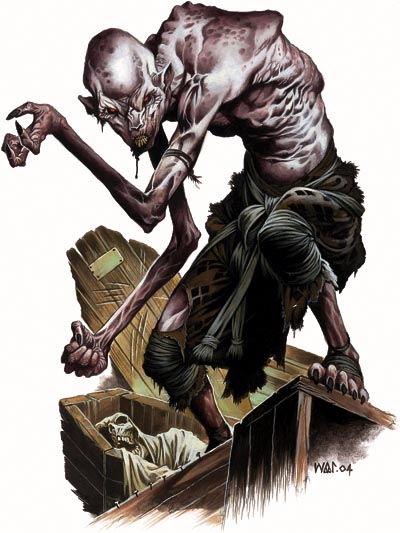 Medium Undead (Augmented Humanoid)
Hit Dice: 6d12 (39 hp)
Initiative: +8
Speed: 50 ft. (10 squares)
Armor Class: 23 (+4 Dex, +4 Wis, +2 bracers, +1 monk, +2 natural), touch 19, flat-footed 19
Base Attack/Grapple: +4/+11
Attack: Unarmed strike +7 melee (1d8+3) or bite +7 melee (1d6+3 plus paralysis)
Full Attack: Flurry of unarmed strikes +6/+6 melee (1d8+3) or bite +7 melee (1d6+3 plus paralysis) and 2 claws +5 melee (1d4+1 plus paralysis)
Space/Reach: 5 ft./5 ft.
Special Attacks: Flurry of blows, ghoul fever, ki strike (magic), paralysis
Special Qualities: Darkvision 60 ft., diet dependent, evasion, purity of body, slow fall 30 ft., still mind, undead traits, +2 turn resistance
Saves: Fort +5, Ref +9, Will +9
Abilities: Str 16, Dex 18, Con —, Int 12, Wis 19, Cha 10
Skills: Balance +11, Climb +12, Hide +13, Jump +13, Move Silently +8, Tumble +13
Feats: Deflect Arrows, Dodge, Improved Grapple, Improved Initiative, Improved Trip, Improved Unarmed Strike, Mobility, Multiattack, Spring Attack
Environment: Any
Organization: Solitary or group (2–5)
Challenge Rating: 7
Treasure: Standard
Alignment: Neutral
Advancement: By character class
Level Adjustment: +2
Medium Undead (Augmented Humanoid)
Hit Dice: 6d12 (39 hp)
Initiative: +8
Speed: 50 ft. (10 squares)
Armor Class: 23 (+4 Dex, +4 Wis, +2 bracers, +1 monk, +2 natural), touch 19, flat-footed 19
Base Attack/Grapple: +4/+11
Attack: Unarmed strike +7 melee (1d8+3) or bite +7 melee (1d6+3 plus paralysis)
Full Attack: Flurry of unarmed strikes +6/+6 melee (1d8+3) or bite +7 melee (1d6+3 plus paralysis) and 2 claws +5 melee (1d4+1 plus paralysis)
Space/Reach: 5 ft./5 ft.
Special Attacks: Flurry of blows, ghoul fever, ki strike (magic), paralysis
Special Qualities: Darkvision 60 ft., diet dependent, evasion, purity of body, slow fall 30 ft., still mind, undead traits, +2 turn resistance
Saves: Fort +5, Ref +9, Will +9
Abilities: Str 16, Dex 18, Con —, Int 12, Wis 19, Cha 10
Skills: Balance +11, Climb +12, Hide +13, Jump +13, Move Silently +8, Tumble +13
Feats: Deflect Arrows, Dodge, Improved Grapple, Improved Initiative, Improved Trip, Improved Unarmed Strike, Mobility, Multiattack, Spring Attack
Environment: Any
Organization: Solitary or group (2–5)
Challenge Rating: 7
Treasure: Standard
Alignment: Neutral
Advancement: By character class
Level Adjustment: +2
This foul humanoid wears a loose shift, but its mottled, decaying flesh is still clearly visible, drawn tightly over bones. Hairless, it has a carnivore’s sharp teeth and eyes like hot coals.
Combat
This creature attacks with surprise, attempting to grapple a target and drag it away from its allies before they can react.
Diet Dependent: All gravetouched ghouls are diet dependent (see the Undead Metabolism section in Chapter 1) upon flesh.
Evasion (Ex): If this gravetouched ghoul monk is exposed to any effect that normally allows it to attempt a Reflex saving throw for half damage, it takes no damage with a successful saving throw.
Ghoul Fever (Su): Disease—bite, Fortitude DC 13, incubation period 1 day, damage 1d3 Con and 1d3 Dex. The save DC is Charisma-based.
Paralysis (Ex): Those hit by this gravetouched ghoul monk’s bite or claw must make a DC 13 Fortitude save or become paralyzed for 1d4+1 rounds. Elves have immunity to this paralysis. The save DC is Charisma-based.
Purity of Body (Ex): Immune to all normal diseases. Magical and supernatural diseases still affect it.
Slow Fall (Ex): A gravetouched ghoul monk within arm’s reach of a wall can use it to slow its descent while falling. It takes damage as if the fall were 30 feet shorter than it actually is.
Still Mind (Ex): +2 bonus on saves against spells and effects of the enchantment school. Possessions: Bracers of armor +2, potion of bull’s strength (2), silver necklace (900 gp), 5 pp.
CREATING A GRAVETOUCHED GHOUL
“Gravetouched ghoul” is an acquired template that can be added to any corporeal aberration, fey, giant, humanoid, or monstrous humanoid with Intelligence and Charisma scores of 3 or higher (referred to hereafter as the base creature).
A gravetouched ghoul speaks all the languages it spoke in life (usually Common). It has all the base creature’s statistics and special abilities except as noted here.
Size and Type: The creature’s type changes to undead, and it gains the augmented subtype. Do not recalculate base attack bonus, saves, or skill points. Size is unchanged.
Hit Dice: Increase to d12.
Armor Class: The base creature’s natural armor bonus improves by 2.
Attack: A gravetouched ghoul retains all the attacks of the base creature and also gains a bite and two claw attacks if it didn’t already have them. If the base creature uses weapons, the gravetouched ghoul retains this ability. A creature with natural weapons retains those natural weapons. A gravetouched ghoul fighting without weapons uses its bite attack. A gravetouched ghoul armed with a weapon uses its bite or weapon as it desires.
Full Attack: A gravetouched ghoul fighting without weapons uses its bite and two claws to attack. If armed with a weapon, it chooses whether to use the weapon or use its natural attacks.
Damage: Gravetouched ghouls have bite and claw attacks. If the base creature does not have this attack form, use the appropriate damage value from the table below according to the gravetouched ghoul’s size. Creatures that have other kinds of natural weapons retain their old damage values or use the appropriate value from the table below, whichever is better.
| Size | Bite Damage | Claw Damage |
|---|---|---|
| Fine | 1 | — |
| Diminutive | 1d2 | 1 |
| Tiny | 1d3 | 1d2 |
| Small | 1d4 | 1d3 |
| Medium | 1d6 | 1d4 |
| Large | 1d8 | 1d6 |
| Huge | 2d6 | 1d8 |
| Gargantuan | 2d8 | 2d6 |
| Colossal | 4d6 | 2d8 |
Ghoul Fever (Su): Disease—bite, Fortitude save, incubation period 1 day, damage 1d3 Con and 1d3 Dex.
An afflicted humanoid who dies of ghoul fever rises as a ghoul at the next midnight. A humanoid who becomes a ghoul in this way retains none of the abilities it possessed in life. It is not under the control of any other ghouls, but it hungers for the flesh of the living and behaves like a normal ghoul in all respects. A humanoid of 4 HD or higher rises as a ghast, rather than a ghoul.
Paralysis (Ex): Victims hit by a gravetouched ghoul’s bite or claw attack must make a successful Fortitude save or be paralyzed for 1d4+1 rounds. Elves have immunity to this paralysis.
Special Qualities: A gravetouched ghoul retains all the special qualities of the base creature and gains those described below.
Turn Resistance (Ex): A gravetouched ghoul has +2 turn resistance.
Diet Dependent: Gravetouched ghouls are diet dependent (see the Undead Metabolism section in Chapter 1) upon flesh.
Abilities: Increase from the base creature as follows: Str +2, Dex +4, Int +2, Wis +4, Cha +2. As an undead creature, a gravetouched ghoul has no Constitution score.
Feats: A gravetouched ghoul retains all its feats, and it gains Multiattack as a bonus feat.
Environment: Any, usually same as base creature.
Organization: Solitary, gang (2–4 ghouls plus 1 gravetouched ghoul), or pack (7–12 ghouls plus 1–4 gravetouched ghouls).
Challenge Rating: Same as the base creature +1.
Alignment: Base creature’s alignment changes to chaotic evil.
Level Adjustment: Same as base creature +2.
GRAVE DIRT GOLEM |
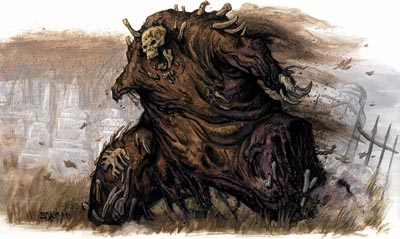 Large Construct
Hit Dice: 11d10+30 (90 hp)
Initiative: –1
Speed: 20 ft. (4 squares), can’t run
Armor Class: 20 (–1 size, –1 Dex, +12 natural), touch 8, flatfooted 20
Base Attack/Grapple: +8/+19
Attack: Slam +13 melee (2d8+6 plus soiled wound)
Full Attack: 2 slams +13 melee (2d8+6 plus soiled wound)
Space/Reach: 10 ft./10 ft.
Special Attacks: Berserk, soiled wound
Special Qualities: Construct traits, damage reduction 5/adamantine and bludgeoning, darkvision 60 ft., immunity to magic, low-light vision
Saves: Fort +3, Ref +2, Will +3
Abilities: Str 23, Dex 9, Con —, Int —, Wis 11, Cha 1
Skills:—
Feats:—
Environment: Any
Organization: Solitary, pair, or gang (3–4)
Challenge Rating: 9
Treasure: None
Alignment: Always neutral
Advancement: 12–18 HD (Large); 19–33 HD (Huge)
Level Adjustment:—
Large Construct
Hit Dice: 11d10+30 (90 hp)
Initiative: –1
Speed: 20 ft. (4 squares), can’t run
Armor Class: 20 (–1 size, –1 Dex, +12 natural), touch 8, flatfooted 20
Base Attack/Grapple: +8/+19
Attack: Slam +13 melee (2d8+6 plus soiled wound)
Full Attack: 2 slams +13 melee (2d8+6 plus soiled wound)
Space/Reach: 10 ft./10 ft.
Special Attacks: Berserk, soiled wound
Special Qualities: Construct traits, damage reduction 5/adamantine and bludgeoning, darkvision 60 ft., immunity to magic, low-light vision
Saves: Fort +3, Ref +2, Will +3
Abilities: Str 23, Dex 9, Con —, Int —, Wis 11, Cha 1
Skills:—
Feats:—
Environment: Any
Organization: Solitary, pair, or gang (3–4)
Challenge Rating: 9
Treasure: None
Alignment: Always neutral
Advancement: 12–18 HD (Large); 19–33 HD (Huge)
Level Adjustment:—
This humanoid golem is composed of magically coherent grave earth. A grave dirt golem wears no clothing, though sometimes the clothing or the gear of past victims can be found mixed in with the medium of its form.Preceded by the smell of carrion, this humanoid creature is formed of moist (almost muddy) earth, mixed in with small bone bits, teeth, and rotting cloth scraps, topped with a dirt-encrusted humanoid skull. Its legs are short and thick, and its chest and arms somewhat tapering.
A grave dirt golem cannot speak or make any vocal noise. It walks and moves with a slow, clumsy gait. It weighs around 800 pounds.
COMBAT
No one likes to be hit by a grave dirt golem because its filth fouls the wounds of its enemies.
Berserk (Ex): When a grave dirt golem enters combat, there is a cumulative 1% chance each round that its elemental spirit breaks free and the golem goes berserk. An uncontrolled golem goes on a rampage, attacking the nearest living creature or smashing some object smaller than itself if no creature is within reach, then moving on to spread more destruction. Once a grave dirt golem goes berserk, no known method can reestablish control.
Construct Traits: A grave dirt golem has immunity to poison, magic sleep effects, paralysis, stunning, disease, death effects, necromancy effects, mind-affecting spells and abilities (charms, compulsions, phantasms, patterns, and morale effects), and any effect that requires a Fortitude save unless it also works on objects or is harmless. It is not subject to extra damage from critical hits, nonlethal damage, ability damage, ability drain, fatigue, exhaustion, or energy drain. It cannot heal damage, but it can be repaired. It also has darkvision out to 60 feet and lowlight vision. As a construct, a grave dirt golem has no Constitution score, but it gains 30 bonus hit points due to its size (which are included in the statistics above).
Immunity to Magic (Ex): A grave dirt golem is immune to spells, spell-like abilities, and supernatural effects, just as if the attacker had failed to overcome spell resistance. The only exceptions are as follows: A move earth spell drives the grave dirt golem back 120 feet and deals 3d12 points of damage. A disintegrate spell slows the golem (as the slow spell) for 1d6 rounds and deals 1d12 points of damage. An earthquake spell cast directly at a grave dirt golem stops it from moving on its next turn and deals 5d10 points of damage. The golem receives no saving throw against any of these effects.
Any magical attack against a grave dirt golem that deals electricity damage heals 1 point of damage for every 3 points of damage it would otherwise deal. If the amount of healing would cause the golem to exceed its full normal hit points, it gains any excess as temporary hit points that last for up to 1 hour. A grave earth golem receives no saving throw against magical attacks that deal electricity damage.
Soiled Wound (Ex): The wound inflicted by a grave dirt golem is caked with grave dirt. Suffused with negative energy, the soiled wound deals an extra 2d4 points of negative energy damage on the round subsequent to its delivery, after which the dirt in the wound becomes inert.
CONSTRUCTION
A grave dirt golem’s body must be formed from a volume of grave soil (soil dug from the immediate vicinity of a grave). This soil must weigh at least 1,000 pounds, and it must be treated with rare oils and powders worth at least 1,500 gp. Creating the body requires a DC 15 Craft (sculpting) check.
CL 11th; Craft Construct (see Monster Manual, page 303), animate objects, commune, resurrection, caster must be at least 11th level; Price 36,500 gp; Cost 18,250 gp + 1,400 XP.